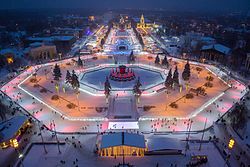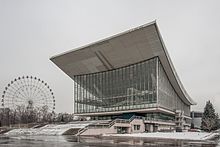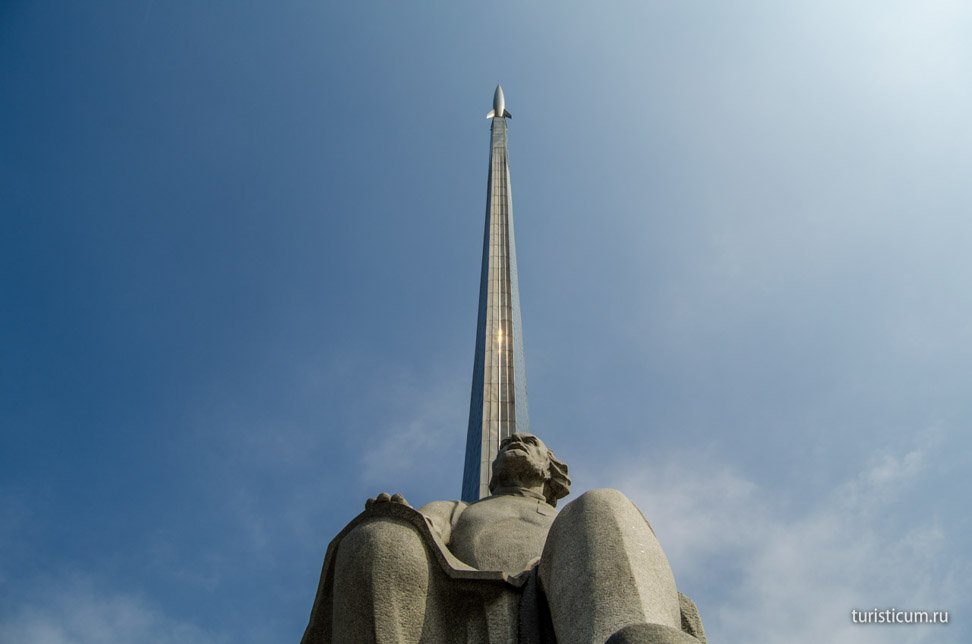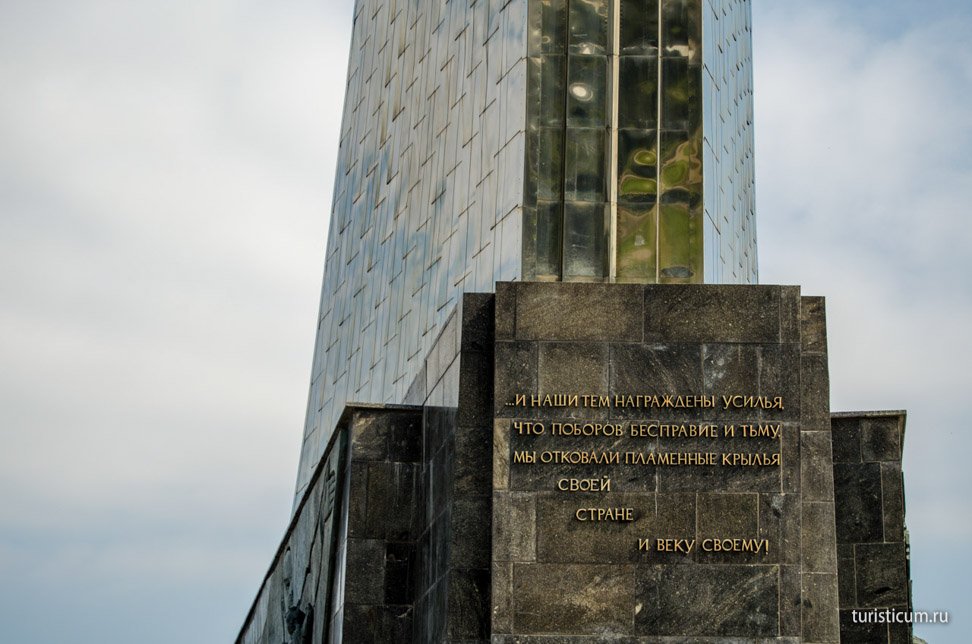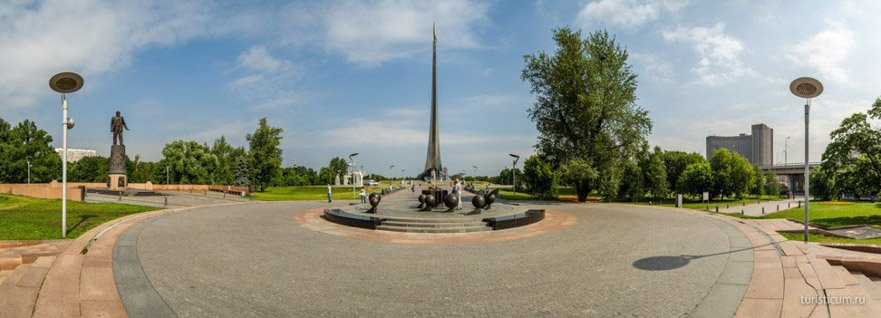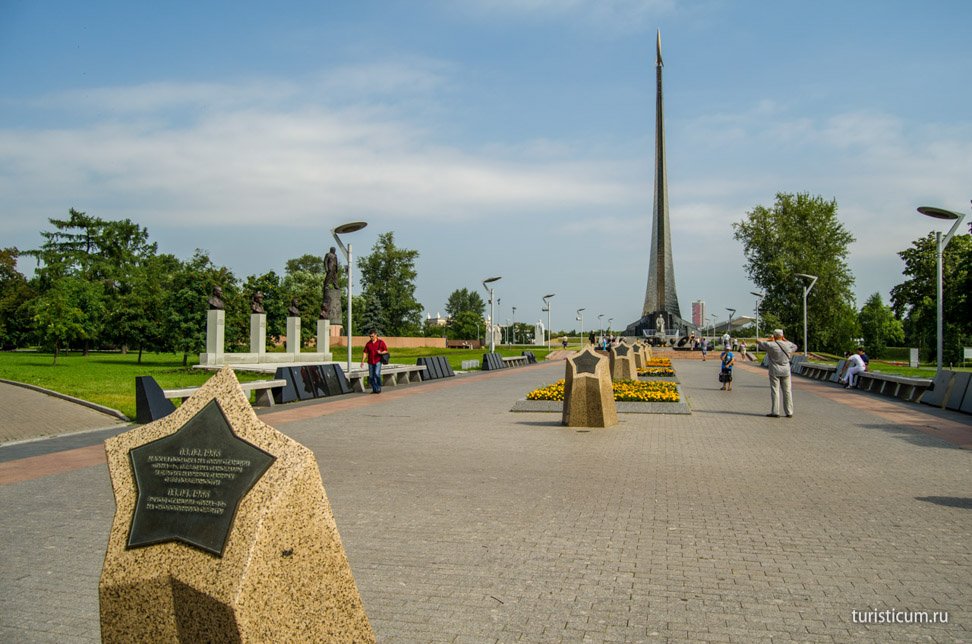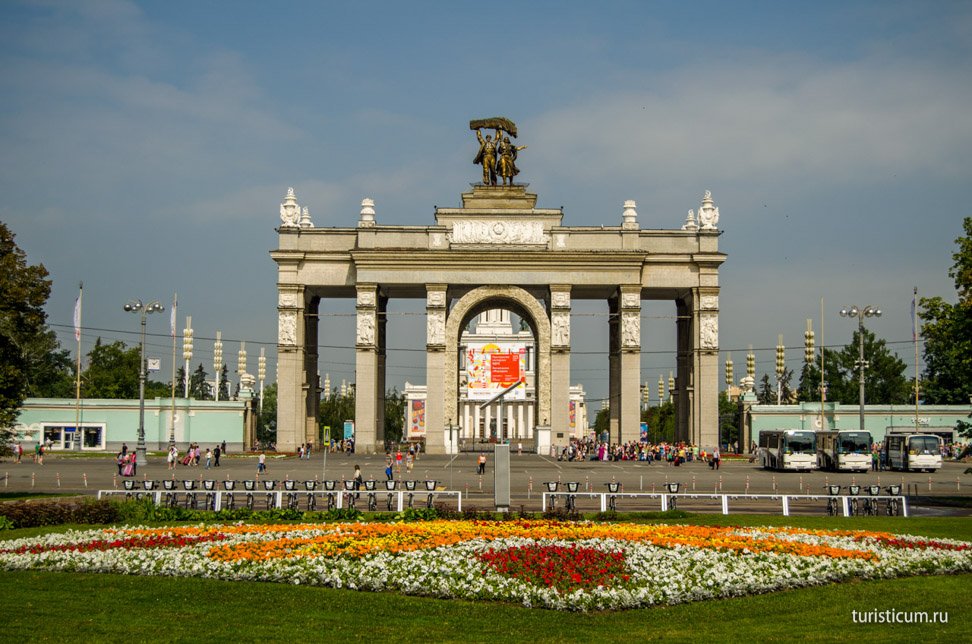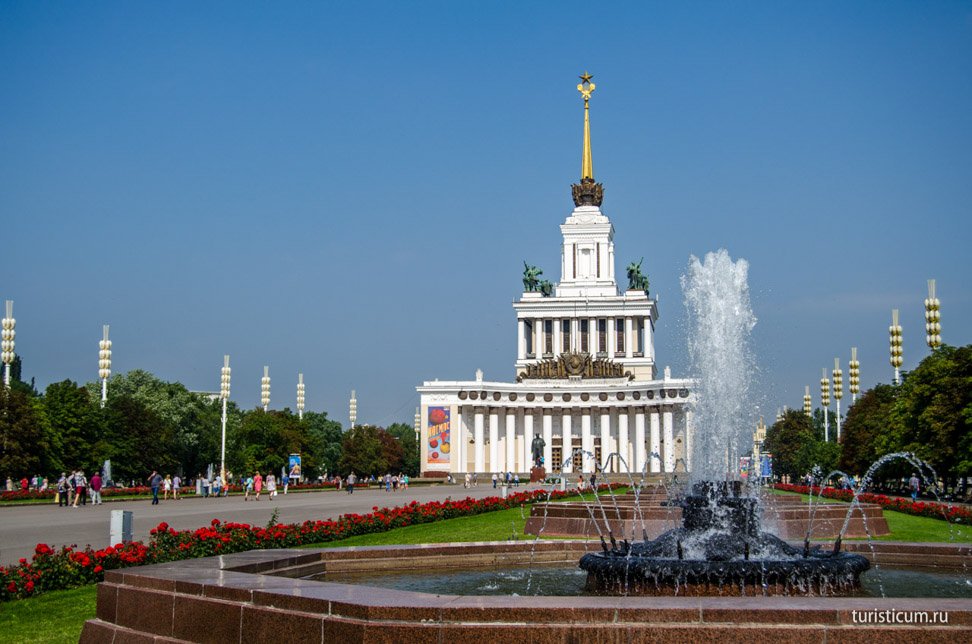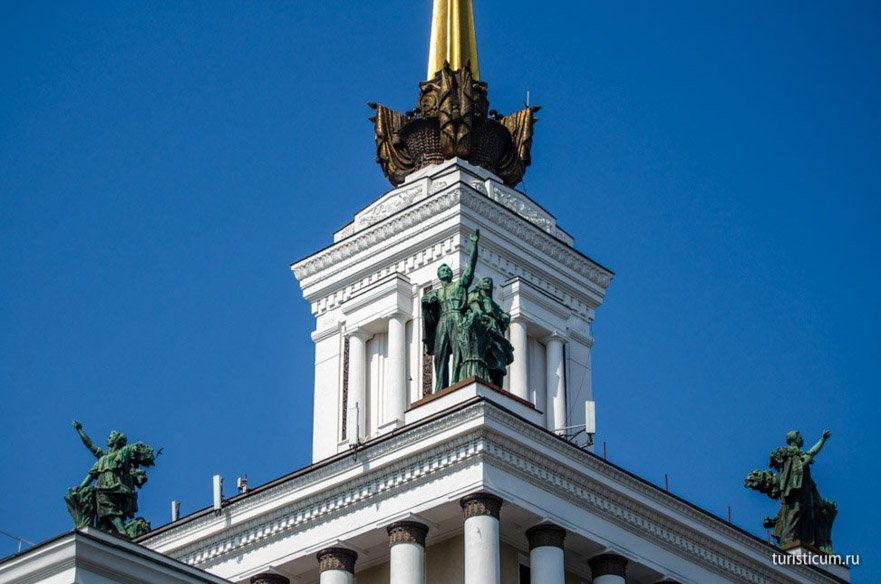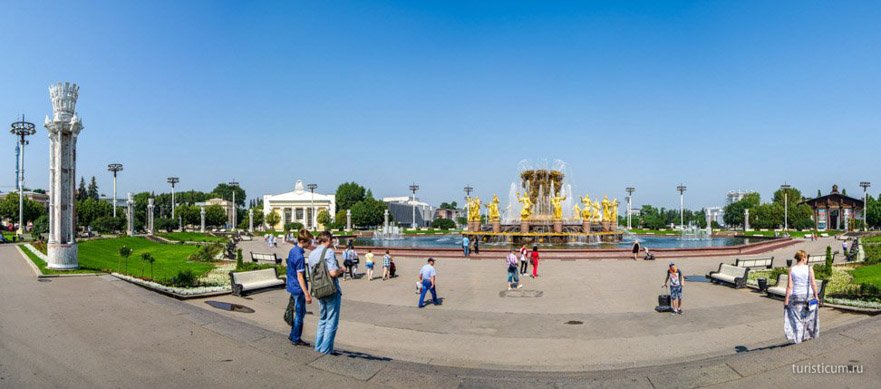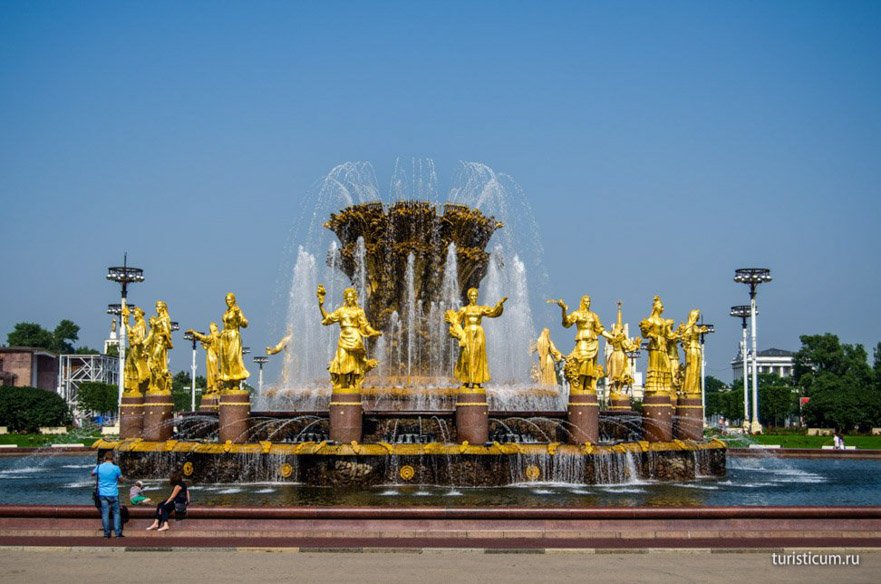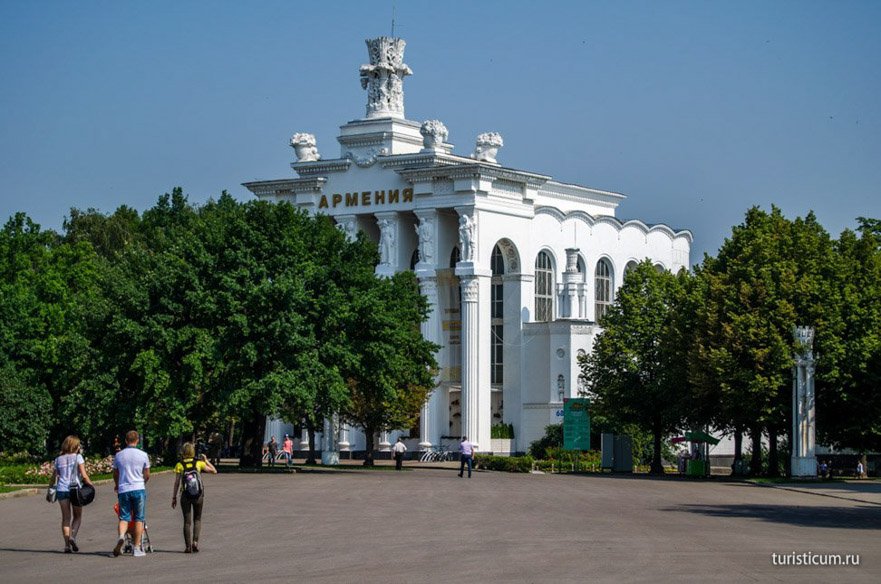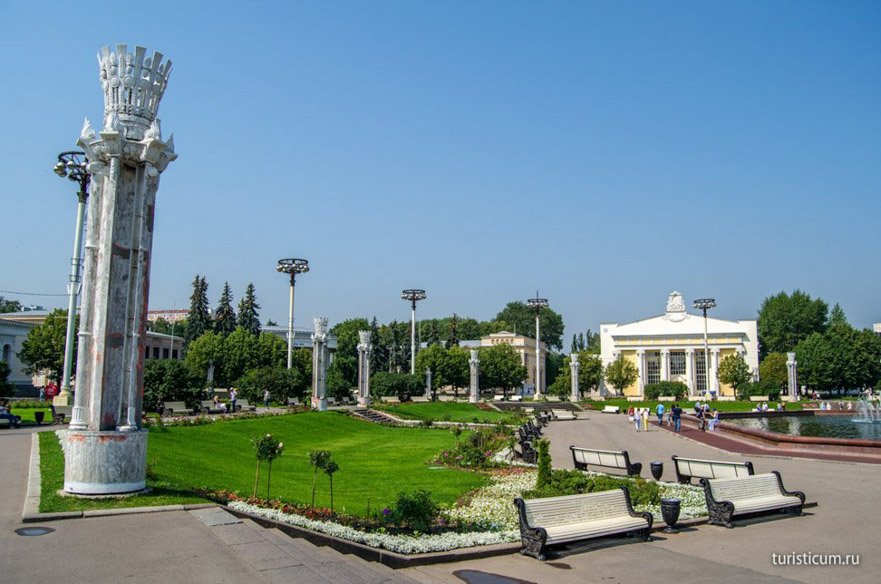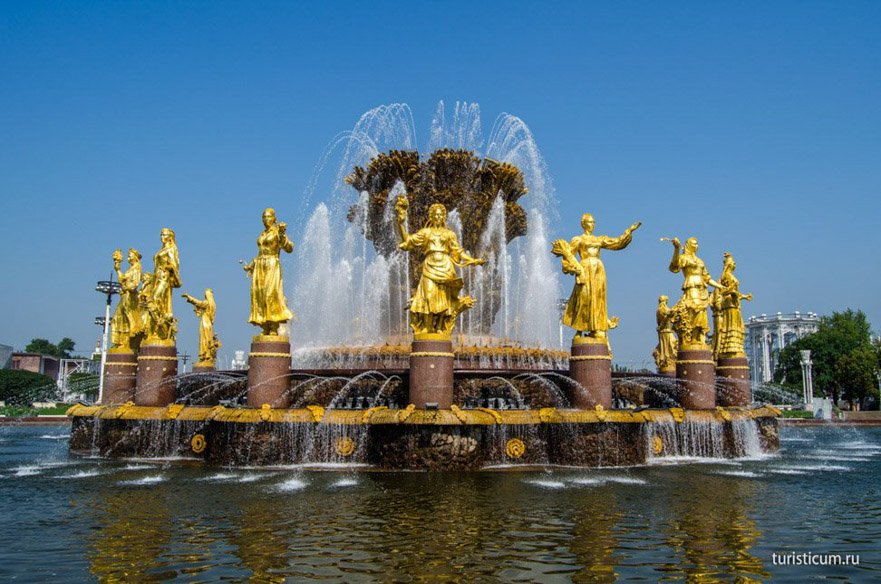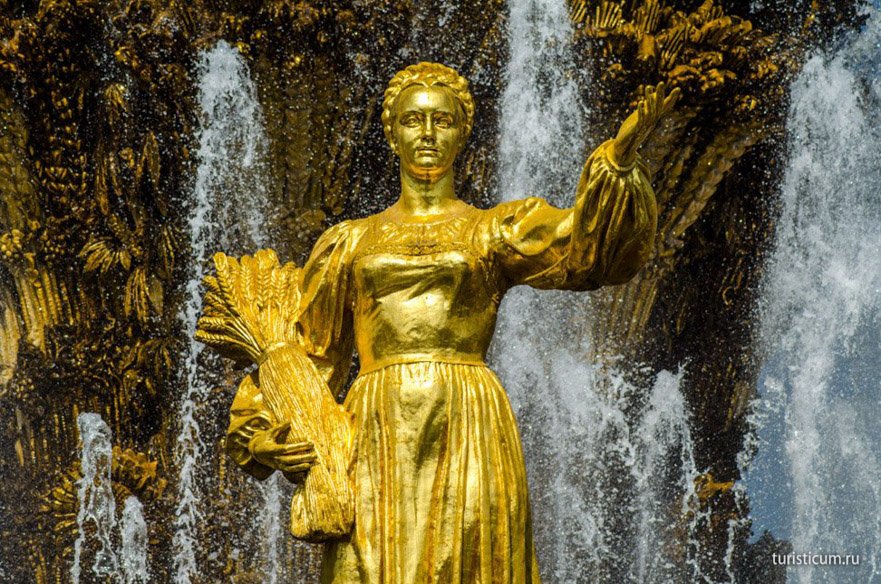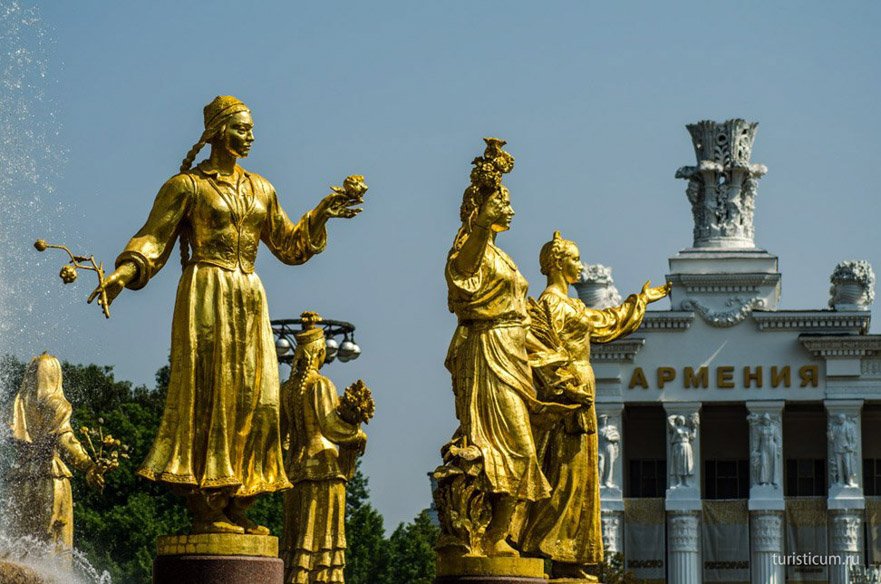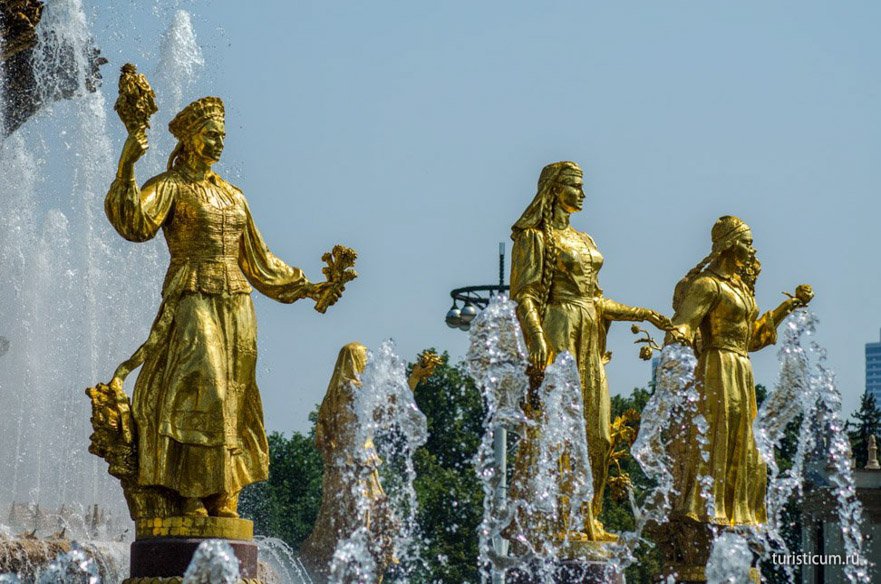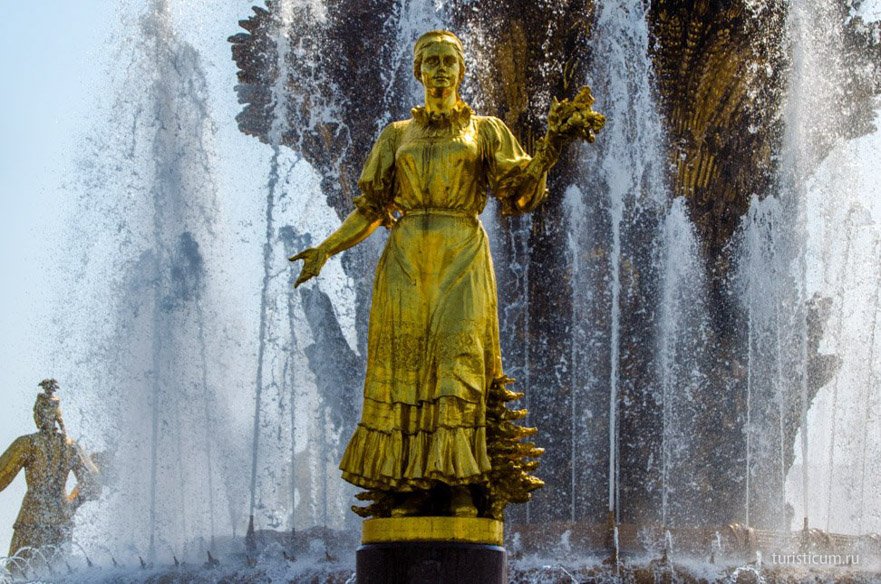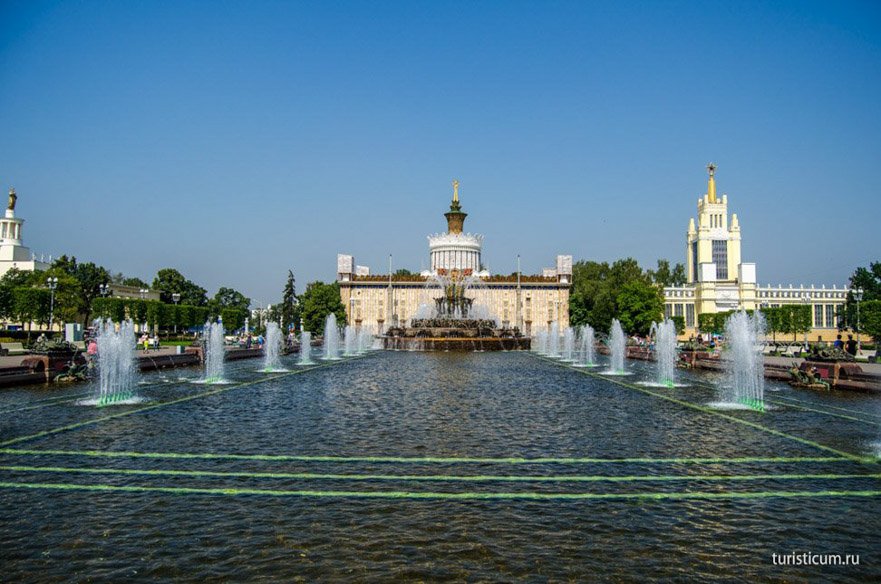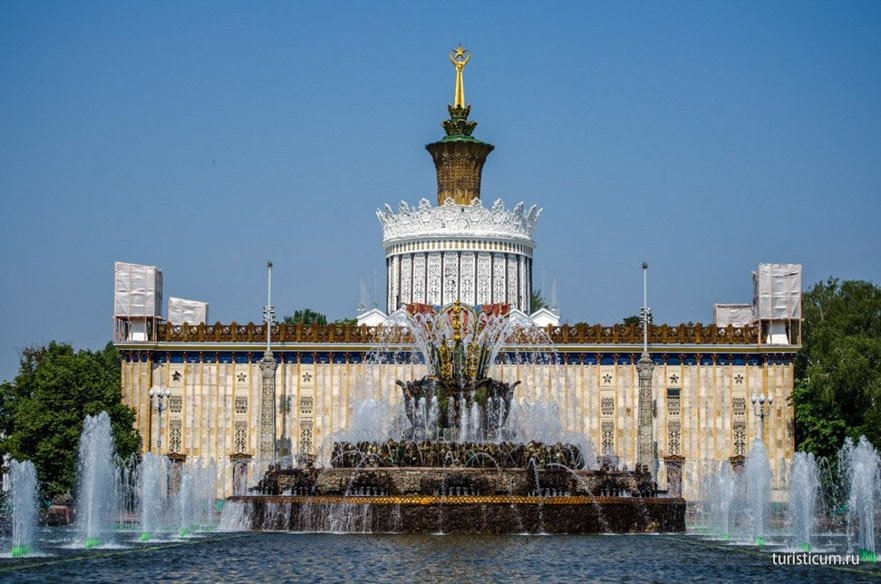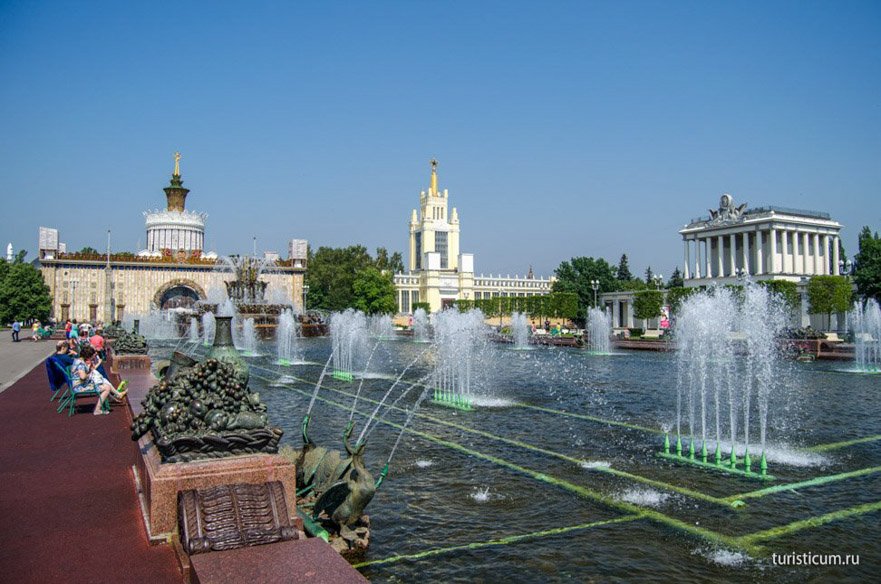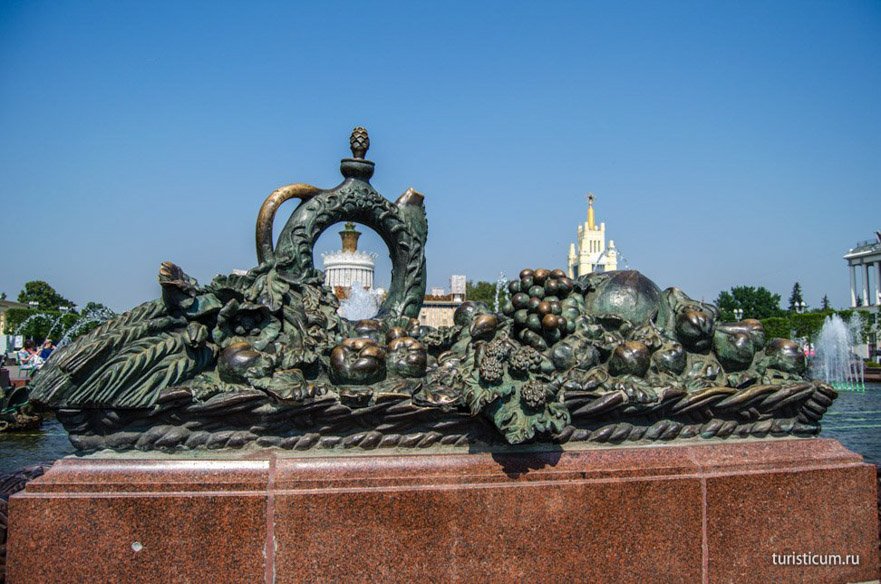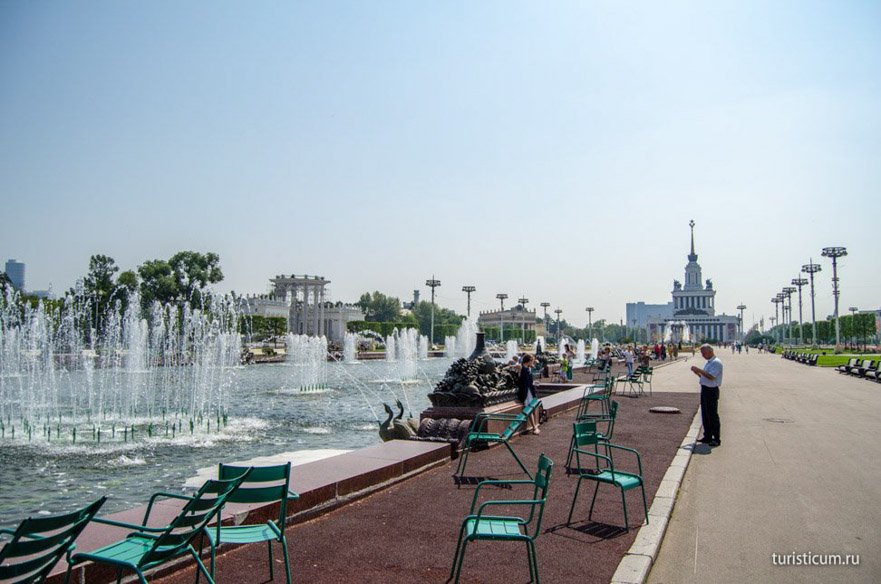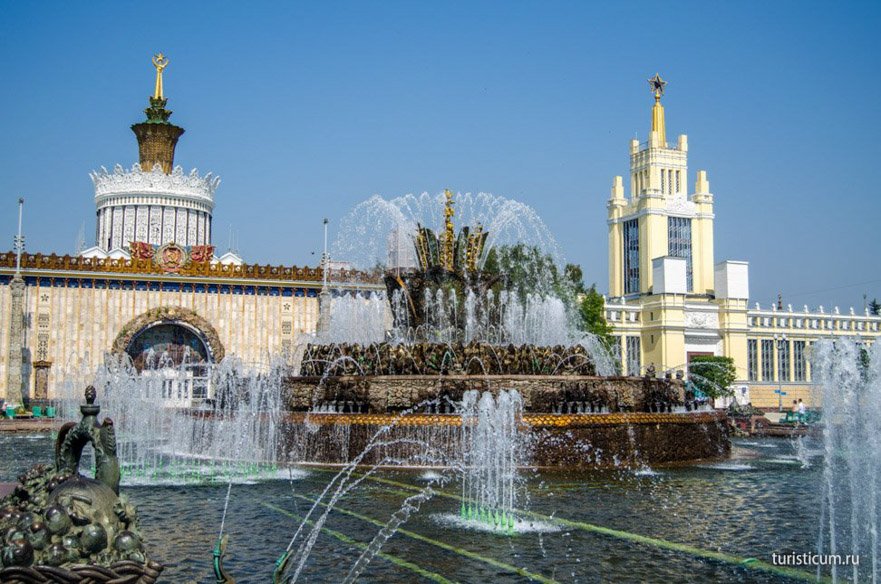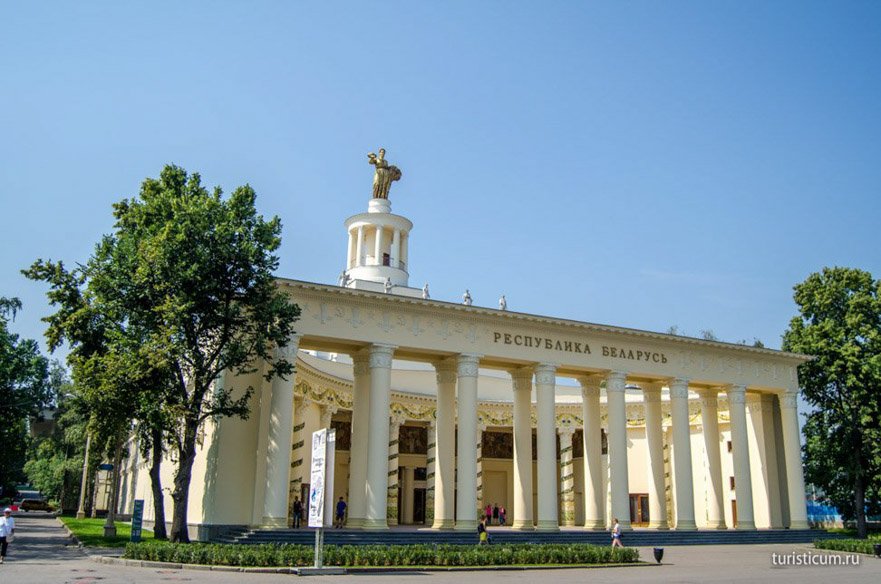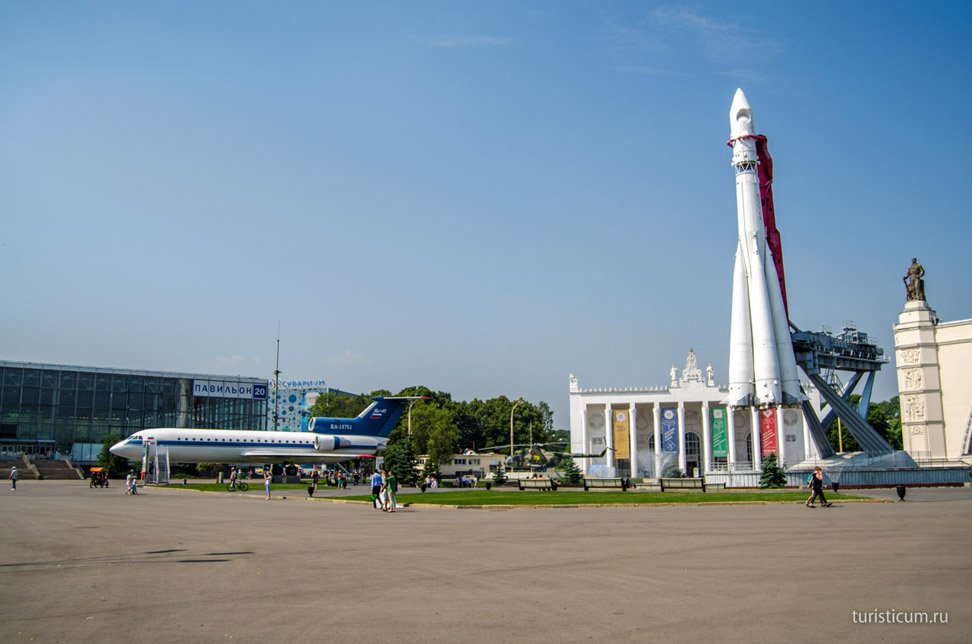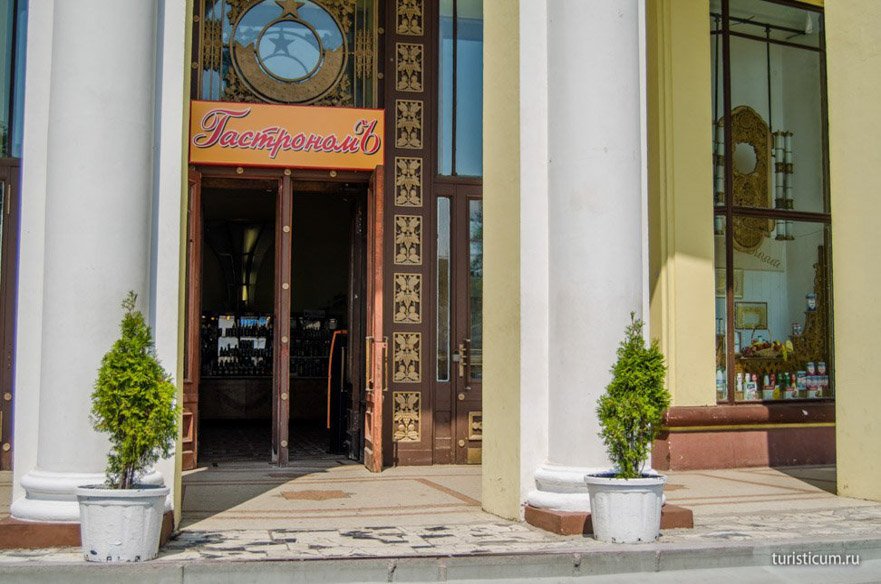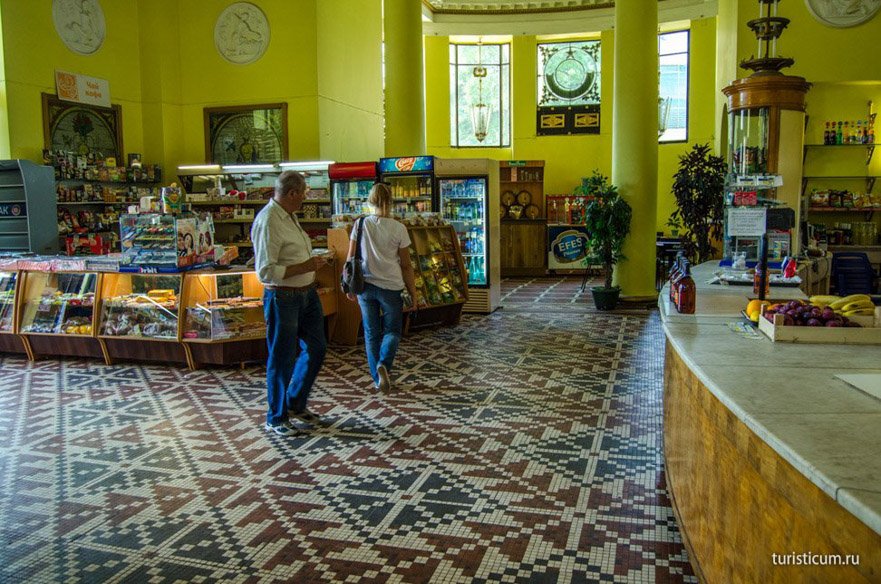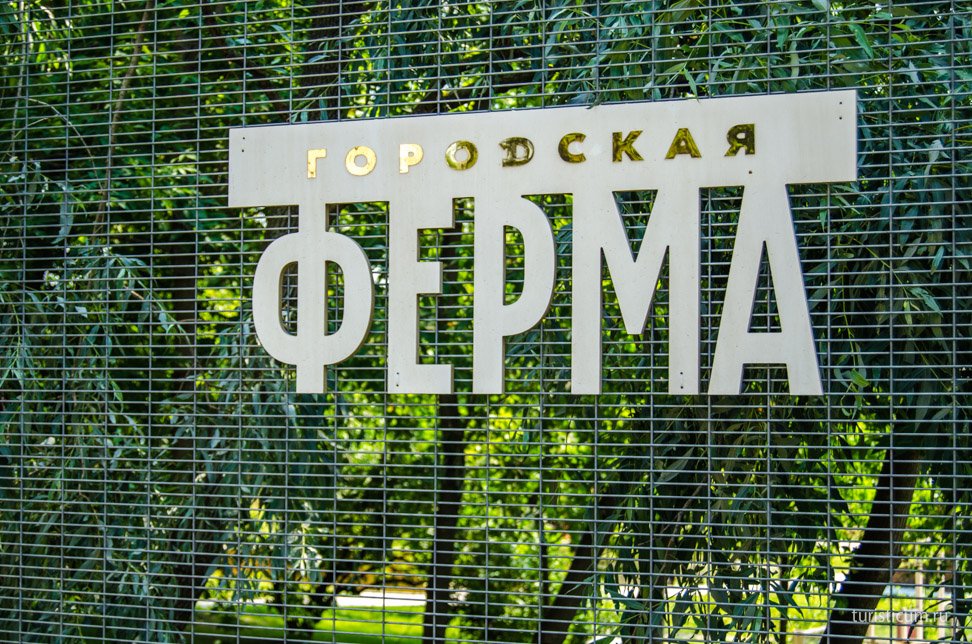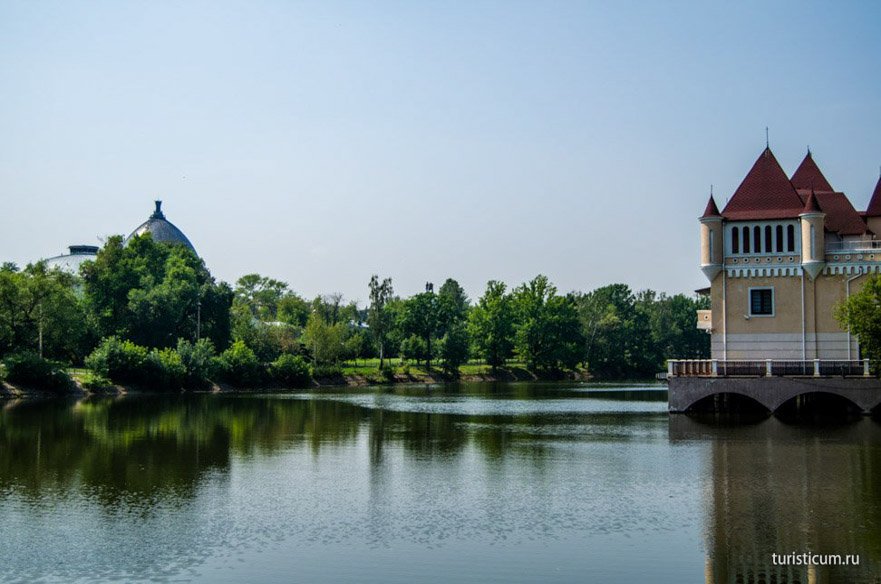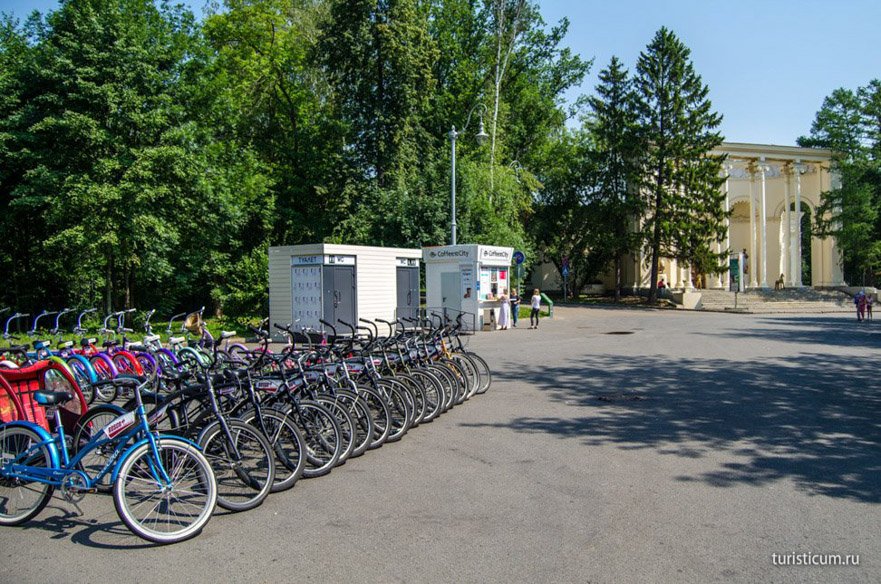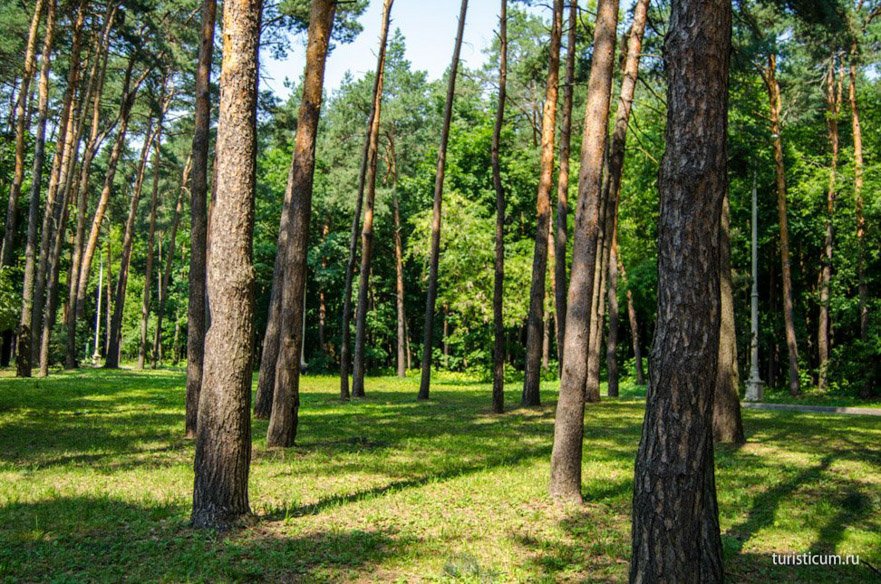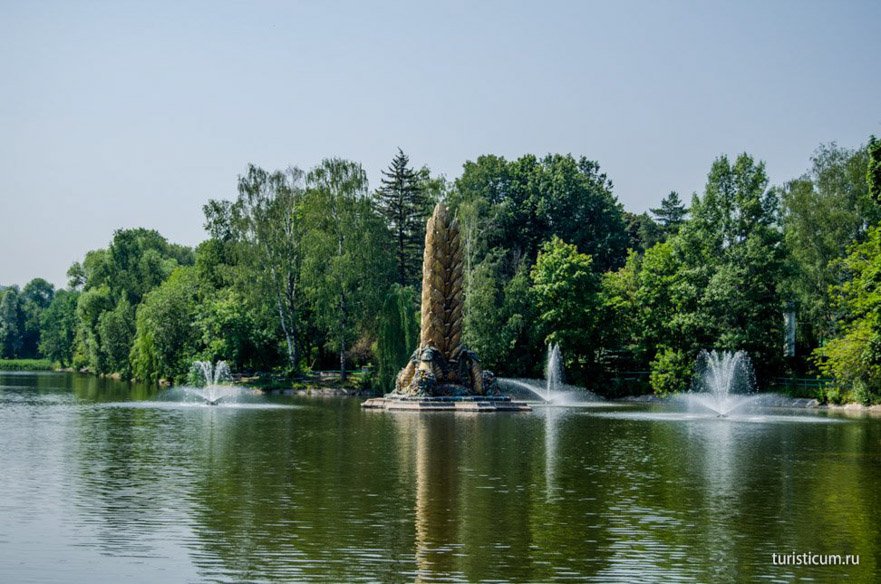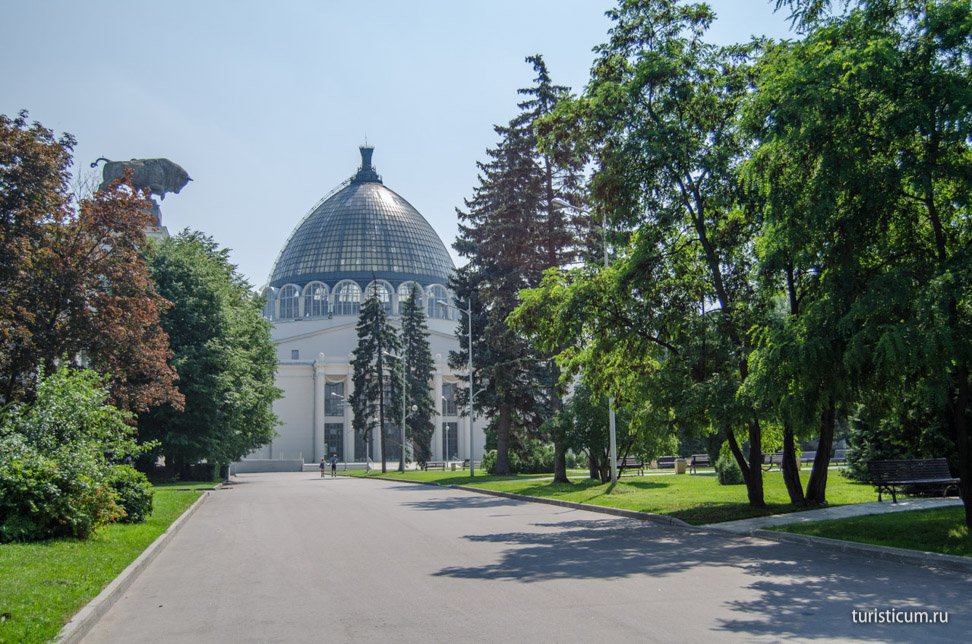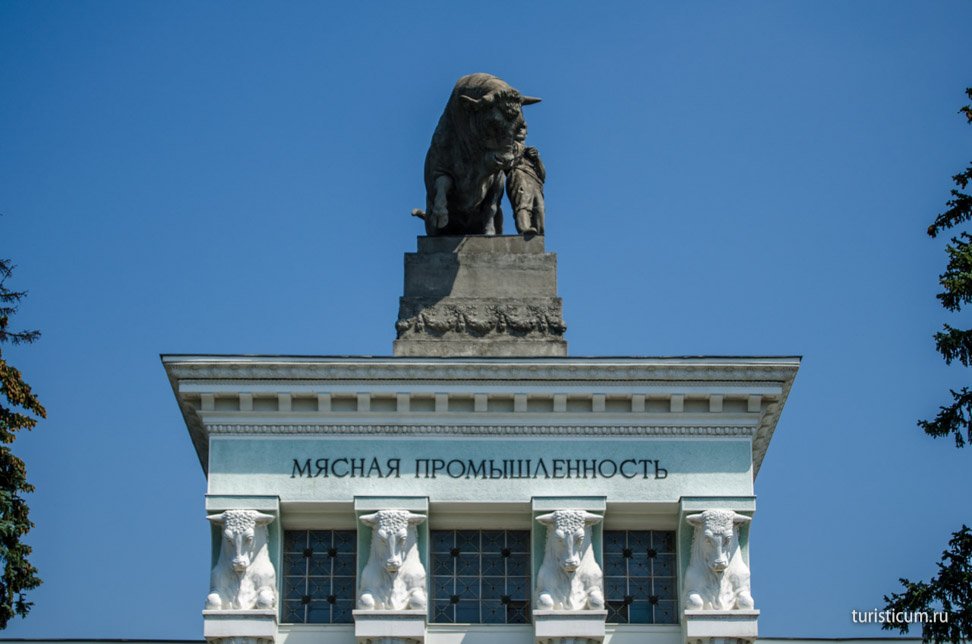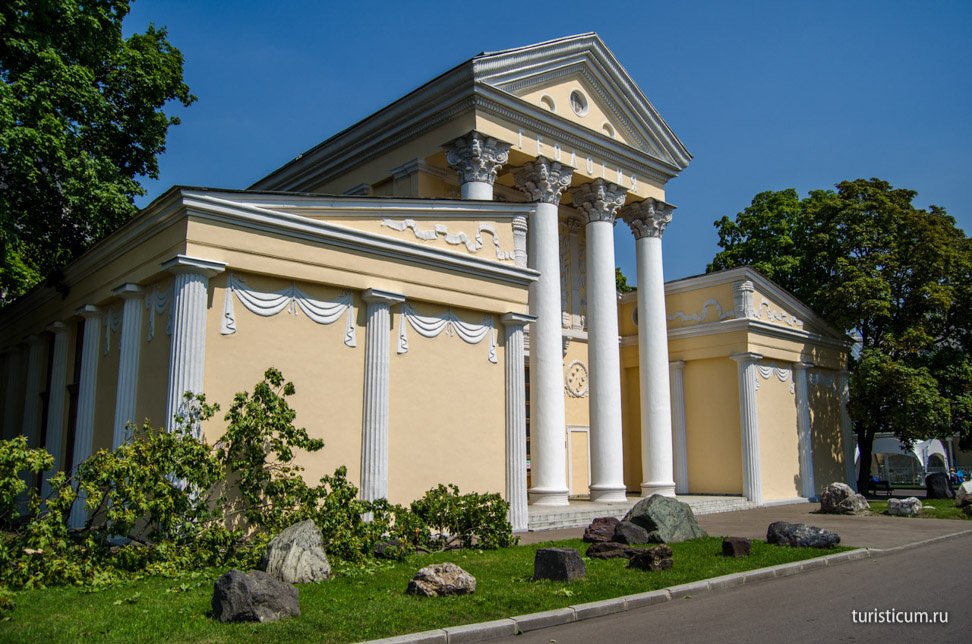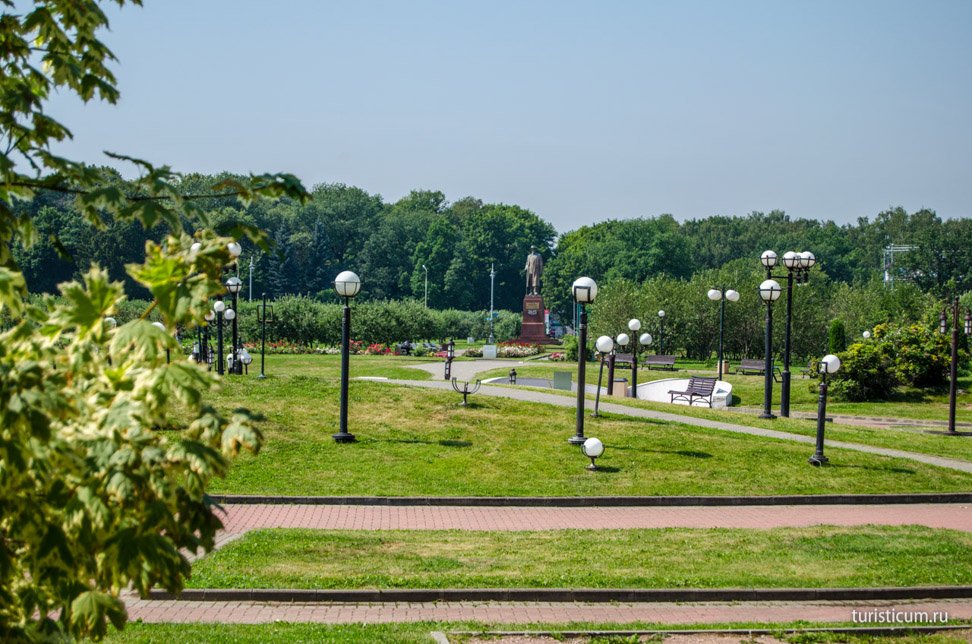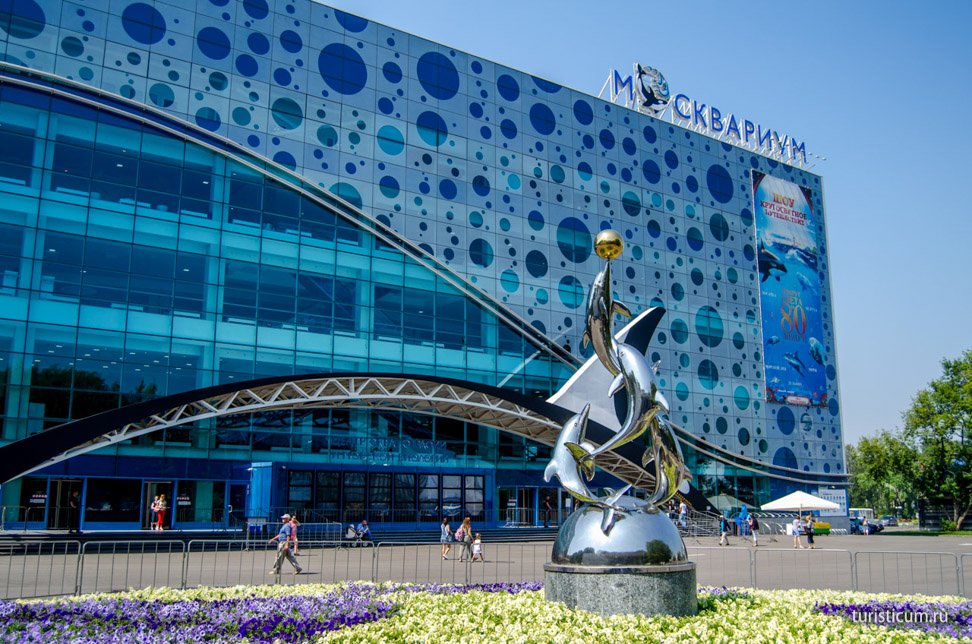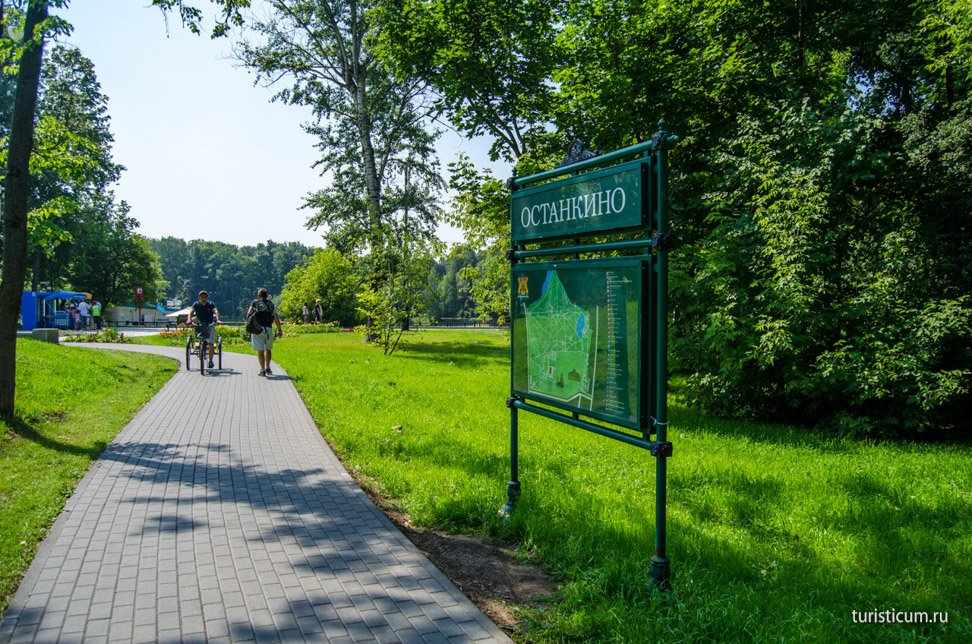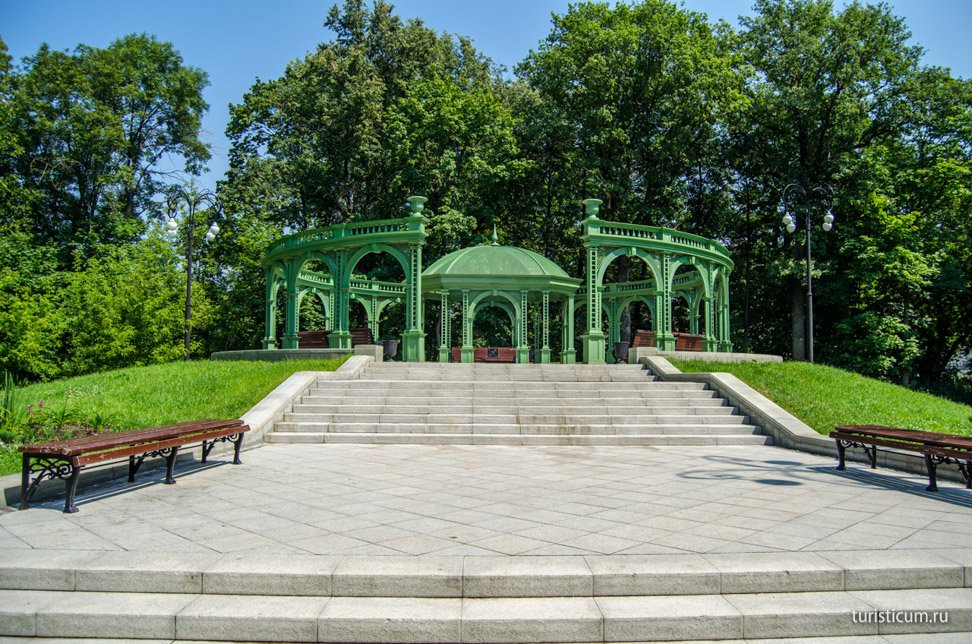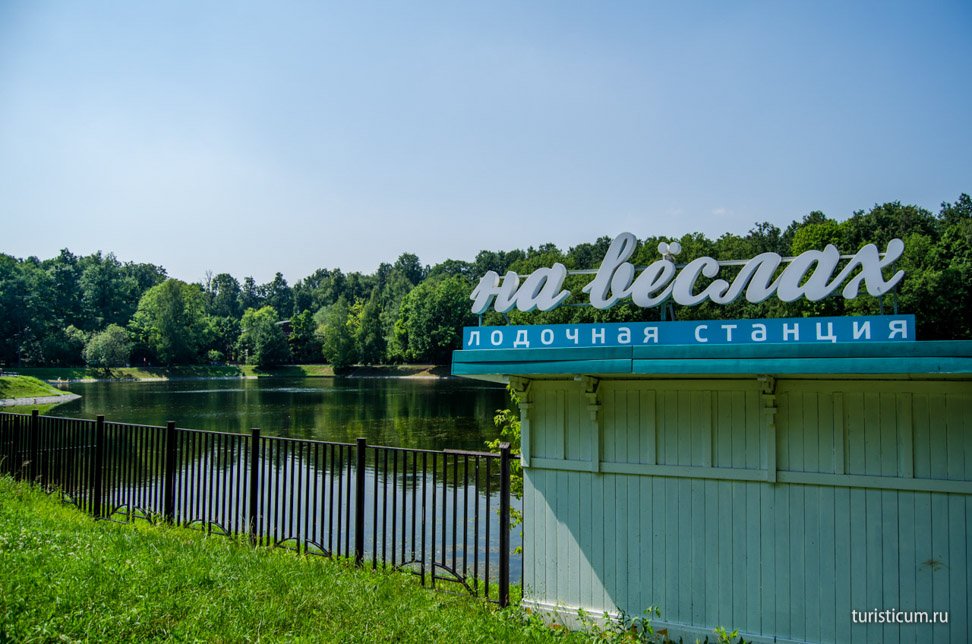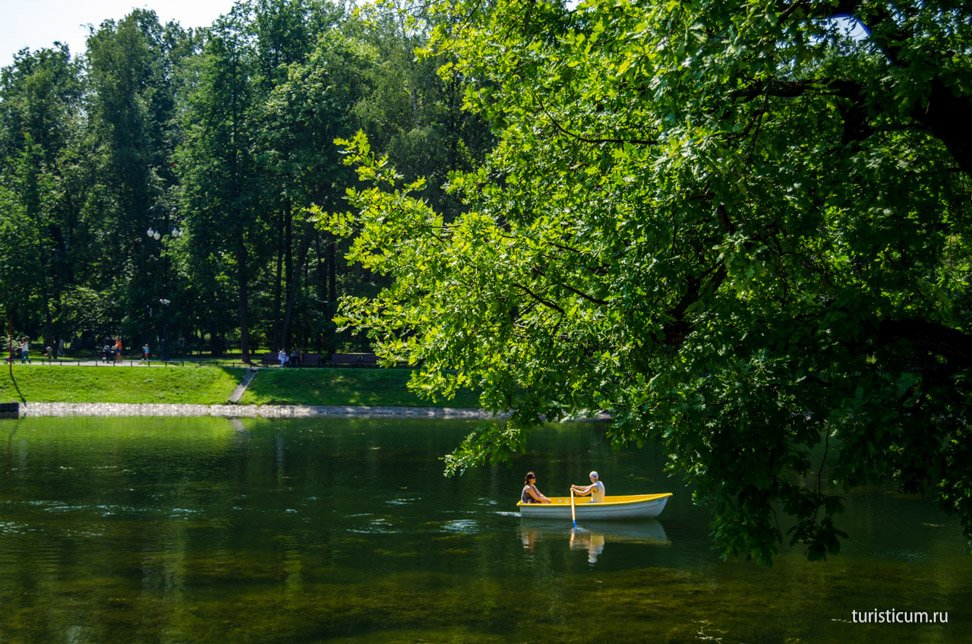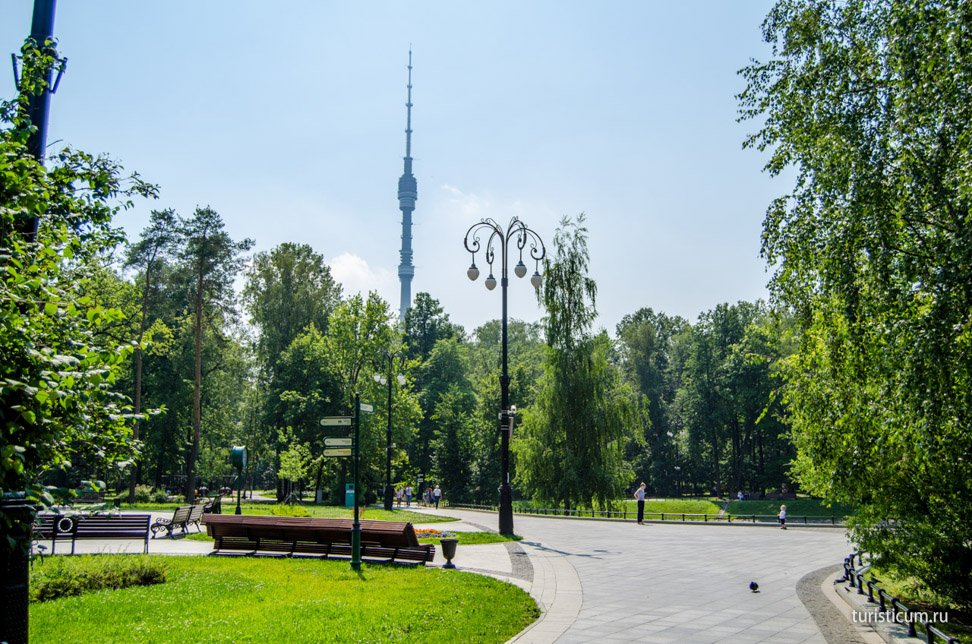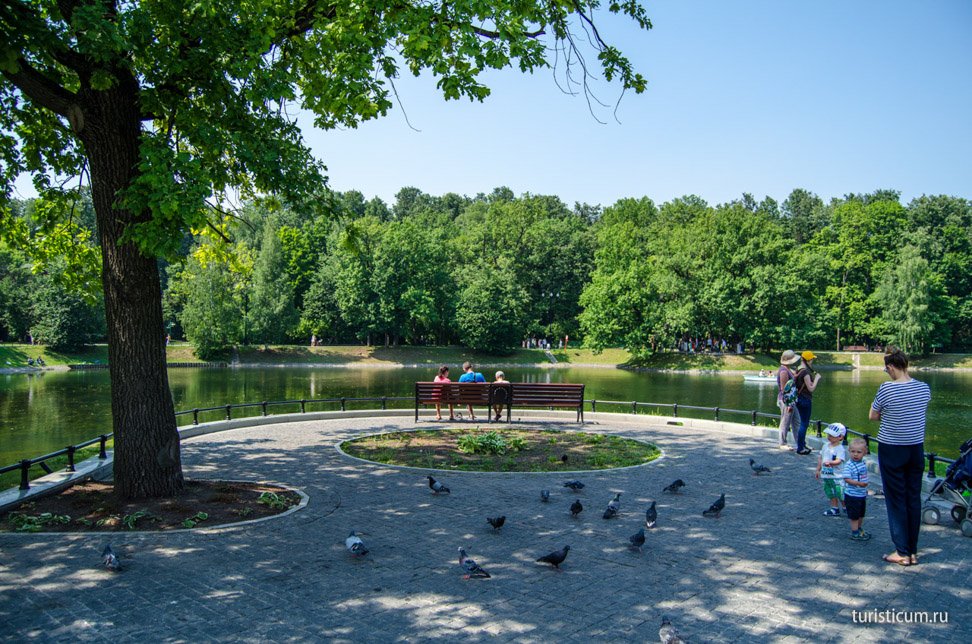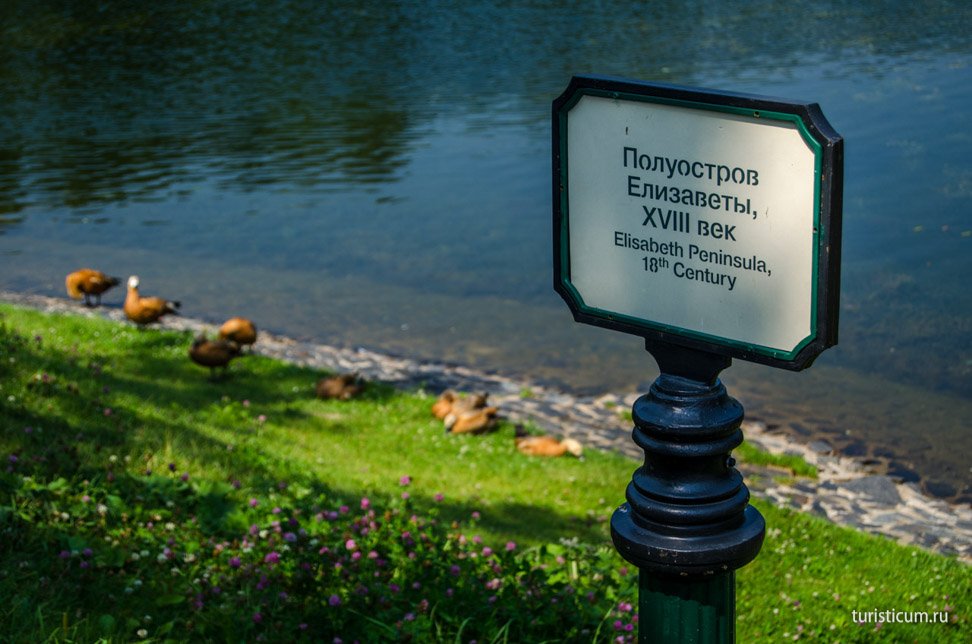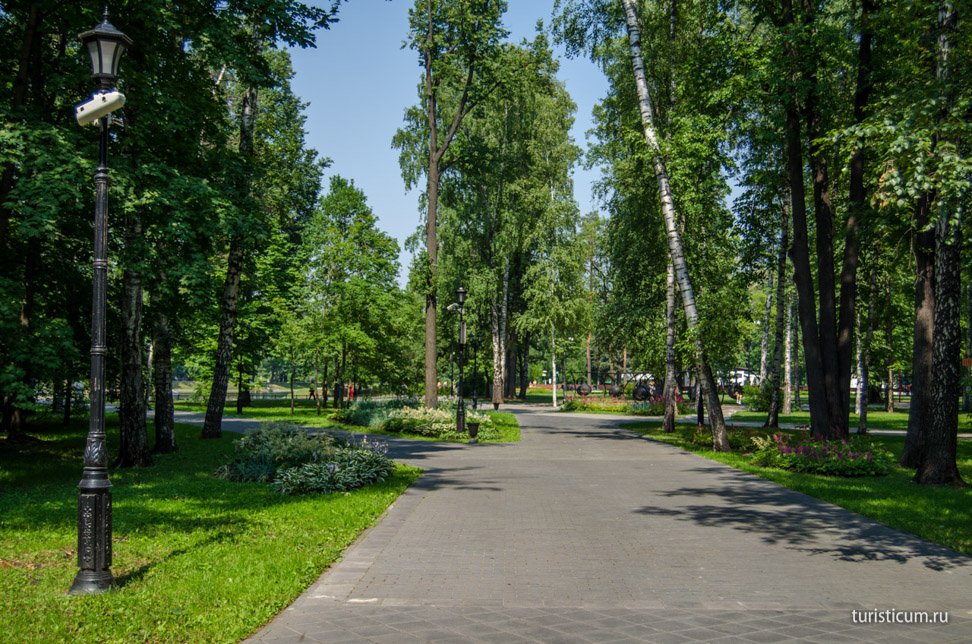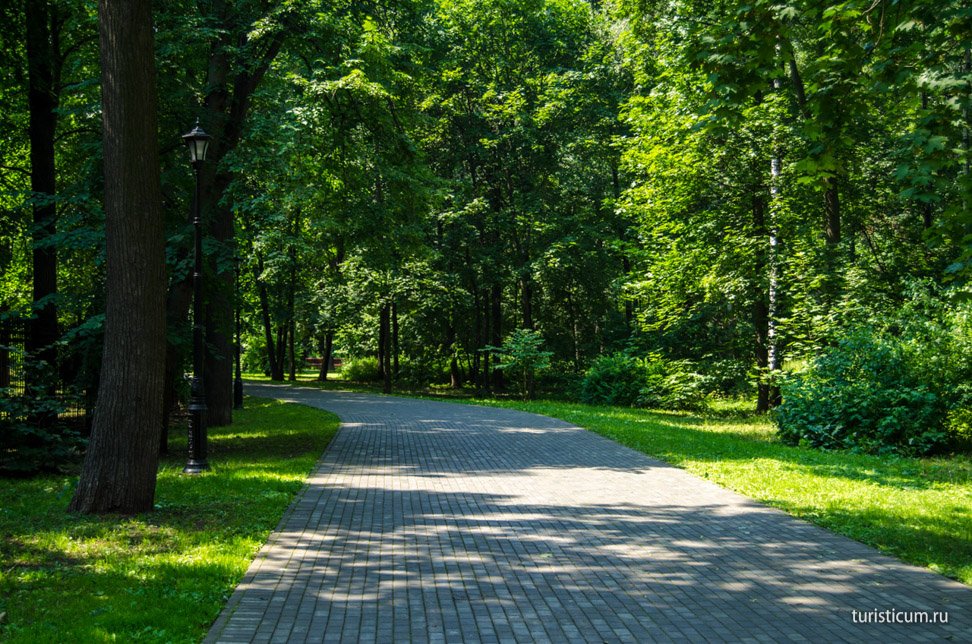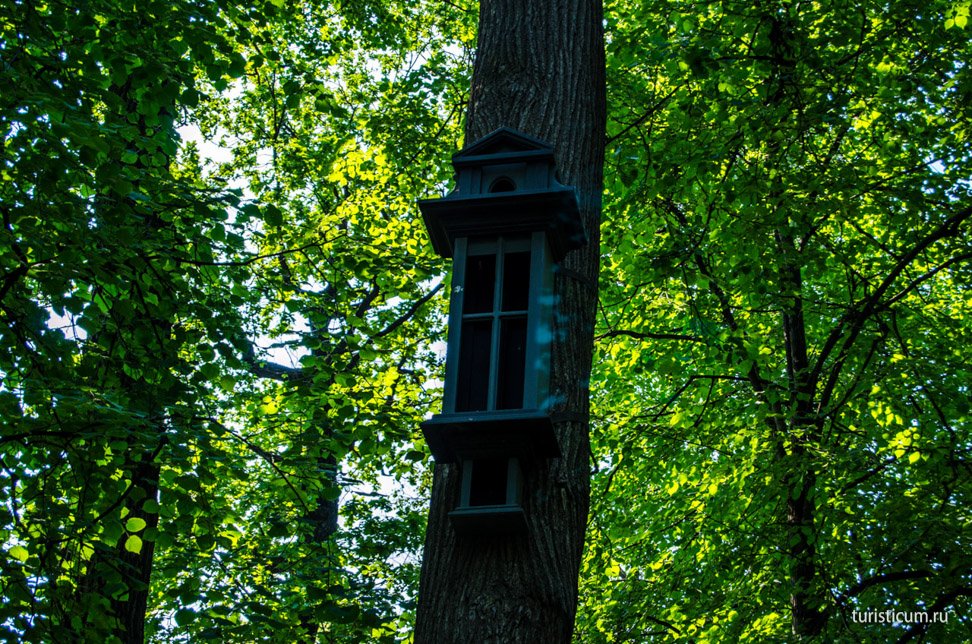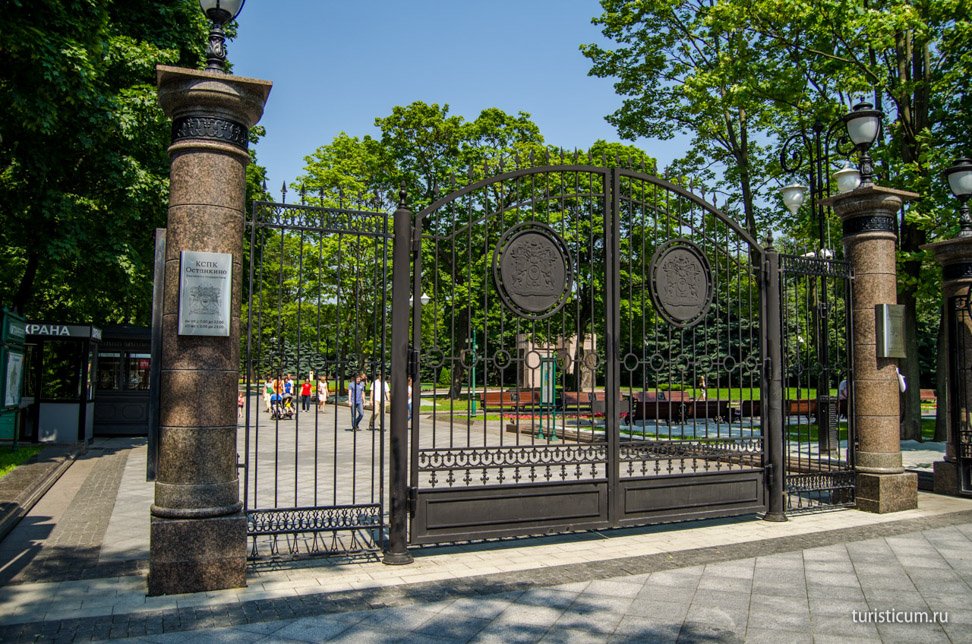| VDNKh | |
|---|---|
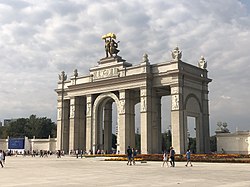
The main entrance to VDNKh |
|
 |
|
| Location | Moscow, Russia |
| Coordinates | 55°49′47″N 37°37′56″E / 55.82972°N 37.63222°ECoordinates: 55°49′47″N 37°37′56″E / 55.82972°N 37.63222°E |
| Opened | 17 February 1935 |
|
Former names |
All-Union Agricultural Exhibition (VSKhV) |
| Enclosed space | |
| Website | |
| vdnh.ru/en/ |
Exhibition of Achievements of National Economy (Russian: Выставка достижений народного хозяйства, Vystavka dostizheniy narodnogo khozyaystva, abbreviated as VDNKh or VDNH, Russian: ВДНХ, pronounced [vɛ dɛ ɛn xa]) is a permanent general purpose trade show and amusement park in Moscow, Russia.[1] Between 1991 and 2014, it was also called the All-Russia Exhibition Centre (Russian: Всероссийский выставочный центр). It is a state joint-stock company.
Location and transportation[edit]
VDNKh is located in Ostankinsky District of Moscow, less than a kilometer from Ostankino Tower. It is served by VDNKh subway station, as well as by Moscow Monorail. Cosmonauts Alley and the Worker and Kolkhoz Woman statue are situated just outside the main entrance to VDNKh. It also borders Moscow Botanical Garden and a smaller Ostankino Park [ru], and in recent years the three parks served as a united park complex.
Map
History[edit]
1935–1939 construction[edit]
The exhibition was established February 17, 1935 as the All-Union Agricultural Exhibition (VSKhV) (Russian: Всесоюзная сельско-хозяйственная выставка; Vsesoyuznaya selsko-khozyaystvennaya vystavka). An existing site (then known as Ostankino Park, a country territory recently incorporated into the city limits), was approved in August 1935. The master plan by Vyacheslav Oltarzhevsky was approved in April 1936, and the first show season was announced to begin in July 1937 and was designed as a «City of Exhibitions» with streets and public spaces, which was very common in the 1930s of the 20th century.
However, plans did not materialise, and three weeks before the deadline Joseph Stalin personally postponed the exhibition by one year (to August 1938). It seemed that this time everything would be ready on time, but again the builders failed to complete their work, and regional authorities failed to select and deliver proper exhibits. Some pavilions and the 1937 entrance gates by Oltarzhevsky were torn down to be replaced with more appropriate structures (most pavilions were criticised for having no windows). According to Oltarzhevsky’s original plan, all of the pavilions were to be constructed from wood. In 1938, a government commission examined the construction and decided that it did not suit the ideological direction of the moment. The exhibition was considered too modest and too temporary. Oltarzhevsky was arrested, together with the Commissar for Agriculture and his staff, and eventually released in 1943. Later, he worked on the 1947-1953 Moscow skyscraper project.[2]
As a result, in August 1938 Nikita Khrushchev, addressing the assembled Supreme Soviet of the Soviet Union, declared that the site was not ready, and the opening was postponed until August 1939. It finally opened on 1 August 1939, and was open to the public between 08:00 and 23:00 until 25 October with a daily attendance of 40,000. The 1940 and 1941 seasons followed but following German invasion in 1941 the exhibition was closed until the end of World War II.
1939 pavilions, as presented in 1950 album and today:
1948–1959 renovation[edit]
In October 1948 the State ordered the renewal of the Exhibition, starting with the 1950 season. Again, the opening was postponed more than once; the first post-war season opened in 1954 (still as Agricultural exhibition). In the 1956 season the planners set aside an Industrial area within the main territory; more restructuring and rebuilding followed. In 1959 the park was renamed Exhibition of Achievements of the National Economy (Russian: Выставка достижений народного хозяйства, Vystavka dostizheniy narodnovo khozyaystva) or ВДНХ/VDNKh.
By 1989 the exhibition had 82 pavilions with an exhibition area of 700,000 square metres. Each pavilion (including the 1939 «regions») had been dedicated to a particular industry or field: the Engineering Pavilion (1954), the Space Pavilion (1966), the Central Industrial Zones Pavilion (1955), the Atomic Energy Pavilion (1954), the People’s Education Pavilion (1954), the Radioelectronics Pavilion (1958), the Soviet Culture Pavilion (1964).
During Soviet times, each year VDNKh hosted more than 300 national and international exhibitions and many conferences, seminars and meetings of scientists and industry professionals. These events attracted about 11 million visitors annually, including 600,000 guests from outside the Soviet Union. The «Radioelectronics» exhibition hall for some years housed the working (and unique) prototypes of the most advanced ES EVM computers to date, which were time-shared by many research organisations right on the premises.
The most memorable feature of the exhibition site was the Worker and Kolkhoz Woman (Rabochiy i kolkhoznitsa) statue, featuring the gigantic figures of a man and woman holding together the famous «hammer and sickle». The sculpture, which reaches 25 meters toward the sky, was designed by Vera Mukhina and originally crowned the 35-meter-tall Soviet pavilion at the Paris Exposition Internationale des Arts et Techniques dans la Vie Moderne (1937). The statue featured on a logo of Mosfilm, Russia’s largest movie studio.
Present day[edit]
Space Pavilion with Vostok (rocket). The Tupolev Tu-154 (reg. no. SSSR-85005, prod. no. 70M005, 1970 year of production, Model 005) in front of the pavilion was dismantled on September 14, 2008. This Tupolev Tu-154 was used as a flight testbed.
The centre of oceanography and marine biology «Moskvarium»
In 1992, VDNKh was renamed, receiving the new acronym VVC, which remained in use until 2014. It occupies 2,375,000 square metres of which 266,000 square metres are used for indoor exhibits. The territory of VDNKh is greater than that of the Principality of Monaco and has approximately 400 buildings. Inadequate maintenance of Vera Mukhina’s statue caused such disrepair that the statue was disassembled. It was slated to be refurbished and installed on the top of the new pavilion by 2008,[3] but funding shortages lead to dragged-out restoration. It was finally reerected in December 2009, now standing atop of a large constructivist pavilion, apparently recreating the original exhibition pavilion from the 1937 World’s Fair in Paris that it was designed for.
The «VDNKh» (or VVTs) complex still operates including the name of a nearby subway station and some sights:
- pavilions
- fountains
- a luna-park
- Cosmonautics museum
- a rocket and even a Buran spaceсraft
- The centre of oceanography and marine biology “Moskvarium” (or Moscow Oceanarium): 80 aquariums, 8000 species of sea creatures from all over the world including 500 species of fish, killer whales, three metre sharks, dolphins and Russian sturgeon.
During winter, VDNKh converts into a main Skating Rink with a total area of 60,000 square metres (645,835 sq ft) and the ice surface of more than 20,000 square metres (215,278 sq ft), with a capacity of 4,500 people that can use the rink at the same time. It’s the biggest skating rink in Russia and Europe.
Restoration[edit]
On 14 May 2014 the previous name VDNKh was restored, following an interactive poll.[4] In addition, the mayor of Moscow announced that the Russian space shuttle, the structural test article — TVA, which was an attraction and restaurant at Gorky Park in Moscow was to be moved to the VNDKh, to be displayed near the Vostok rocket in front of the Cosmos hall. It was moved 5–6 July 2014 and re-assembled by 21 July.[5]
In addition there is a Su-27 fighter jet on display.
Currently, the larger international exhibitions are mostly held at the new facilities of Moscow Expocentre.
In September 2018, Sergey Shogurov was appointed as CEO of VDNK. Under the leadership of Shogurov, new museum and exhibition spaces were opened, a Landscape Park was created, and objects of cultural heritage were carried out, public electric transport was launched. In 2019, the restoration of the «Fraternity of peoples» and «Stone Flower» fountains was completed.[6]
-
Central Pavilion
-
Central avenue
-
-
The Pavilion of Atomic energy
-
The old entrance gate to the exhibition centre
-
The fountains at the entrance boulvards
-
Cirkorama theatre
-
The entrance to the roller coaster
-
View from the Ferris wheel.
-
The Cosmonautics and Aviation Centre located in the Cosmos pavilion
-
The Propylaea — the central gate entrance
-
Historical Park «Russia-My History»
-
Official bike rental
The site[edit]
The Expo 67 Soviet pavilion was disassembled after that fair closed, and moved to Moscow to become the All-Russia Exhibition Centre — today «Moscow Pavilion».
The exhibition centre was built in the era of Joseph Stalin. The place selected was Moscow’s northern suburb Ostankino. The main planner was Vyacheslav Oltarzhevsky who planned a central avenue with fountains, small roads and a large square facing the central pavilion at the end of the avenue. A statue of Vladimir Lenin used to stand in the front of the pavilion. In the central square there is a big fountain called, Fontan Druzhba Narodov. In English it means, Friendship of People Fountain. Designed in the shape of an octagon, the fountain was created to glorify the people of the Soviet Union. There is another fountain called «The Stone Flower Fountain» facing the Ukraine Pavilion. There is a smaller square facing the Space Pavilion in the centre of which stood a Tupolev Tu-154 aircraft, placed there in 1976 after the pavilion of Agricultural Machinery became the Cosmos Pavilion. This aircraft was later scrapped in 2008.[7] A large statue of Joseph Stalin stood in the square until 1948. This had previously stood on the banks of the Moskva River in the city centre. The square is called The Industrial Square.
The northern area of the site is an area shared between the exhibition centre and the botanic gardens of the nearby Russian Academy of Sciences. In it are agricultural pavilions and estate pools with vegetation including: Michurin’s Garden and the Golden Spike Fountain. All the fountains in the centre are covered with gold. There are also many statues situated throughout the site, particularly of Soviet leaders. In addition, the site houses cinemas, cafés, theatre pavilions as well as a church built after the fall of the Soviet Union.
In the southern area of the complex, near the central entrance there is an Amusement Park with the Moscow-850 Ferris wheel. It was built in 2004 as part of Moscow’s 850th anniversary celebration. The restored Soviet pavilion from Expo 67 in Montreal is now the Moscow Pavilion. Soviet architects’ planned the pavilions and Soviet artists’ designed the fountains. Designed in Stalinist architecture, some pavilions were built in the wedding cake style; such as the Central Pavilion that was famous in the Communist States at that time.
In 2008, the Big Constructivist Pavilion was built as a replica of the original Soviet pavilion. In 2009, the renovated statue of Worker and Kolkhoz woman was erected on top of the building.
The Worker and Kolkhoz woman sculpture was originally created to crown the Soviet pavilion of the World’s Fair. The organizers had placed the Soviet and Nazi pavilions facing each other across the main pedestrian boulevard at the Trocadéro on the north bank of the Seine.
Today visitors can rent a car or a bicycle to tour the site.
See also[edit]
- Sokolniki Exhibition and Convention Centre
References[edit]
- ^ «About VDNH». Archived from the original on 2015-11-12. Retrieved 2015-10-30.
- ^ This section is based on Soviet public documents available in Russian at www.bcxb.ru Archived 2007-05-20 at the Wayback Machine
- ^ ««Рабочий и колхозница». Сложная судьба эталона соцреализма». РИА НОВОСТИ. 2007-04-11. Archived from the original on 19 August 2007. Retrieved 2007-08-09.
- ^ ВВЦ в Москве возвращено историческое название ВДНХ (in Russian). Interfax. 15 May 2014. Retrieved 15 May 2014.
- ^ Petrovitch, Vassili. «Transportation of the shuttle to the VNDKh park». Retrieved 21 February 2015.
- ^ «Гендиректор ВДНХ: очередной этап программы возрождения выставки успешно завершен — ТАСС». webcache.googleusercontent.com. Retrieved 2021-11-02.
- ^ «✈ russianplanes.net ✈ наша авиация».
External links[edit]
- Official website
- Map of the VDNH in infoservices website
- General information in russianmuseums website
- Virtual tours and panoramas of the VDNH
- VDNH in WikiMapia website
- A comprehensive architectural history of the Exhibition in Russian
На основании Вашего запроса эти примеры могут содержать грубую лексику.
На основании Вашего запроса эти примеры могут содержать разговорную лексику.
Перевод «ВДНХ» на английский
VDNH
ENEA
Exhibition Center
Economic Achievements
WDW
pavilion
Эти выходные принесут гостям ВДНХ много-много хорошей музыки.
This weekend VDNH’s guests will be completely plunged into an atmosphere of wonderful music.
Более полувека озеленители ВДНХ выращивают множество сортов тюльпанов.
For more than half a century the landscapers of VDNH grow many varieties of tulips.
Такова небольшая и довольно общая история, нашего ВДНХ.
This is a small and rather common history, our ENEA.
Возрождение ВДНХ сопровождается реализацией новой коммуникационной стратегии.
The rejuvenation of VDNH is accompanied by the implementation of a new communication strategy.
Стратегия развития ВДНХ отталкивается от исторической концепции и учитывает все требования по охране памятников архитектуры.
The development strategy of VDNH is based on the historical concept and takes into consideration all requirements for the protection of architectural monuments.
По тематике детские стихотворения перекликаются с произведениями современной живописи и инсталляциями, дополненными фотографиями из архива ВДНХ.
The theme of children’s poems will resonate with the works of modern painting and installations complemented with photos from the archive of VDNH.
В 1959-м в нем разместилась поликлиника для сотрудников ВДНХ.
In 1959, it housed a medical unit for VDNH employees.
Каток ВДНХ также работает все праздники по расписанию и тарифам выходных дней.
The skating rink of VDNH will also work during all the holidays according to weekend schedule and weekend rate.
Также реставрационные работы ведутся на десятках объектов ВДНХ.
Restoration works are also in progress at dozens of VDNH facilities.
Очевидно, что ВДНХ обладает колоссальным потенциалом как бренд для различных видов продукции.
Obviously the name VDNH has a great potential to be used for a variety of products.
Получив отказ, администрация ВДНХ обратилась в суд.
After the offer was refused, the administration of VDNH appealed to the court.
Этой традиции ВДНХ уже более 60 лет.
This tradition of VDNH is more than 60 years old.
Крупнейшее мероприятие индустрии безопасности пройдет на ВДНХ
The largest event of safety and security industry will be held at VDNH
Не случайно в экспозицию вошли фотографии и документы из архива ВДНХ.
It is no accident that the exhibition includes photographs and documents from the funds of VDNH.
Выступления шести музыкальных коллективов завершили фестиваль духовых оркестров на ВДНХ.
Theperformance of the six musical groups finalized the festival of the brass bandsat VDNH.
На территории ВДНХ ведутся работы по созданию новой транспортной системы.
Works on the development of a new transport system are underway at VDNH.
Как и 75 лет назад, ВДНХ снова демонстрирует достижения сельскохозяйственной отрасли.
Just like 75 years ago, VDNH is once again exhibiting the achievements of the agricultural sector.
Это большая честь — выступить партнером в производстве серии сувениров с павильонами возрожденного парка ВДНХ.
It is an honour to be a partner in the production of a series of souvenirs with pavilions from the revived VDNH park.
Безопасность и экологичность — главные требования ВДНХ при организации игровых зон для детей.
Safety and environmental friendliness are the main requirements of VDNH when organizing children’s play zones.
До конца недели разобранные конструкции должны быть вывезены с территории ВДНХ.
The dismantled structures should be removed from VDNH property by the end of the week.
Результатов: 3367. Точных совпадений: 3367. Затраченное время: 62 мс
- VDNKh is a unique architectural complex built in the Stalinist Empire style, still preserving the memory of its time.
- The territory of VDNKh, now combined with the Botanical Garden and Ostankino Park, forms a vast recreational area.
- Festivals, exhibitions and major festivities take place all year round inside and outside the VDNKh pavilions.
- The ultimate symbol of VDNKh are two central fountains designed by architect K. Topuridze – Friendship of Peoples and Stone Flower.
- The architectural design of some pavilions, such as National Education, Young Naturalists and the Tobacco Pavilion, deserve special attention.
- The area features user-friendly rental points, bike lanes, playgrounds and sports facilities.
VDNKhRussian: ВДНХ (The Exhibition of Achievements of the National EconomyRussian: Vystavka dostizheniy narodnogo hozyaystva or Выставка достижений народного хозяйства) is a unique architectural complex which nowadays serves as a popular public recreation area for Muscovites and visitors to the capital. Its territory is thoughtfully laid out and seamlessly blends both green spaces and infrastructure. The exhibition was integrated with the Botanical GardenRussian: Botanicheskiy sad or Ботанический сад and the Ostankino ParkRussian: парк «Останкино», and as a result, together they now form this vast recreational area. This is also the site of the MoskvariumRussian: Москвариум, one of the biggest indoor aquariums in Europe both in terms of its floor space and the number of sea animals contained inside. Fabulous fountains with remarkable sculptural groups are the jewel in the crown of VDNKh. All kinds of festivals, exhibitions, and fairs are held in the VDNKh pavilions as well as in the open air year round. A huge ice rink operates here in winter.

ARCHITECTURAL MONUMENT OF THE 30-S

A few buildings constructed during the time of the first exhibition have survived to this day. One is the present-day North entranceRussian: Severnyi vhod or Северный вход by architect V. Oltarzhevsky, which used to be the main point of entry into the complex. This very simple uncluttered entrance, made up of a few white arches deprived of any decor might well pass for a modern construction. Harmony of proportions, shapes, and the space around them together with lack of any other decorative elements renders this the embodiment of Constructivist artistic pursuit.

Even if you are in a beautiful historic area or a tidy park, walking around the huge city takes up a lot of energy. For you to have a rest in the best way, on the pages of our website there is a lot of information about the best restaurants in Moscow or best bars in Moscow etc.
LARGE-SCALE RENOVATION


Further along the avenue, VDNKh’s two main fountains are located: “Friendship of PeoplesRussian: Druzhba narodov or Дружба народов” and “Stone FlowerRussian: Kamennyi tsvetok or Каменный цветок”, both by architect K. Topuridze. The former depicts a bunch of golden grain ears, around which, as if in a mass circle dance, representatives of all the USSR republics are depicted. The principle the “Stone Flower” is built on is somewhat more complicated; its basin is bigger and its sculptural shapes depict an enormous opening flower.


However, the 1960s gave rise to some changes to the VDNKh. The former “Engineering” pavilionRussian: pavilon «Mashinostroenie» or павильон «Машиностроение» was rebuilt and renamed the “Space” pavilionRussian: pavilon «Kosmos» or павильон «Космос». This enormous building with a parabolic arch and a large dome is remarkable for its expressive interior design. The spaceflight theme is further maintained on Industrial squareRussian: Promyshlennaya ploshchad’, or Промышленная площадь where there are models of the VostokRussian: Восток carrier rocket and the Yak-42Russian: Як-42 aircraft. In addition, a model of the BuranRussian: Буран space shuttle has recently been added.
GOOD REST

In the last few years, VDNKh has been under renovation. The exhibition was integrated with the Botanical Garden and the Ostankino Park, and as a result, an immense recreational area has now been established. The pavilions are being restored; in the “Central” pavilion, the relief called “Glory to Soviet People – the Standard Bearer of PeaceRussian: Sovetskomu narodu — znamenostsu mira — Slava! or Советскому народу — знаменосцу мира — Слава!”, created by Vuchetich, was found 50 years afterwards. The Moskvarium, entertainment facilities and museums have also been opened in this space. Various exhibitions are held in the pavilions and in the open air. Convenient rental desks, bicycle paths, playgrounds for children, and sports facilities have been set up as well. There are cafes, green areas and beautiful flower beds, too. Many come to this place simply to have a stroll, meet with friends, or learn to roller skate or ice skate. There is always a festive spirit in the air here, and it’s certainly worth a visit.
© 2016-2023 moscovery.com
How interesting and useful was this article for you?
вднх
-
1
ВДНХ
1) General subject: VDNKh , Exhibition of Economic Achievements
Универсальный русско-английский словарь > ВДНХ
-
2
ВВЦ
Универсальный русско-английский словарь > ВВЦ
-
3
Всероссийский выставочный центр
Универсальный русско-английский словарь > Всероссийский выставочный центр
См. также в других словарях:
-
ВДНХ — ВДНХ. Главный вход Павильон «Космос», 1980 год Всероссийский выставочный центр (ВВЦ) выставочный комплекс в Северо Восточном округе Москвы, самый крупный в городе. Общая площадь территории ВВЦ 237,5 га[1], площадь павильонов 134 000 кв. м.… … Википедия
-
Вднх — ВДНХ Выставка достижений народного хозяйства. Существует несколько объектов, носящих или носивших такое имя: Всероссийский выставочный центр (ранее ВДНХ). Выставка достижений народного хозяйства в г. Барнаул. Выставка достижений народного… … Википедия
-
ВДНХ — Выставка достижений народного хозяйства после: ВВЦ … Словарь сокращений и аббревиатур
-
ВДНХ — [вэ дэ эн ха], неизм., ж. Выставка достижений народного хозяйства в Москве. ◘ Среди советизмов аббревиатур немало имен собственных, таких, как СССР, КПСС, ВДНХ. Влахов, Флорин, 159. На территории ВДНХ 82 павильона. БЭС, 259. Раза три ездили … Толковый словарь языка Совдепии
-
«ВДНХ» — Схема линий московского метрополитена 2004 г. (с сайта ). «ВДНХ» (до 1959 «ВСХВ»), станция Калужско Рижской линии. Открыта в 1958. Архитекторы Н.А. Быкова, И.Г. Гохарь Хармандарян, И.Г. Таранов, Ю.А. Черепанов, авторы художественного оформления З … Москва (энциклопедия)
-
ВДНХ СССР — ВДНХ. Главный вход Павильон «Космос», 1980 год Всероссийский выставочный центр (ВВЦ) выставочный комплекс в Северо Восточном округе Москвы, самый крупный в городе. Общая площадь территории ВВЦ 237,5 га[1], площадь павильонов 134 000 кв. м.… … Википедия
-
ВДНХ (значения) — ВДНХ Выставка достижений народного хозяйства. Существует несколько объектов, носящих или носивших такое имя: Всероссийский выставочный центр (ранее ВДНХ). Национальный Экспоцентр Украины (ранее ВДНХ УССР). Выставка достижений… … Википедия
-
Вднх (значения) — ВДНХ Выставка достижений народного хозяйства. Существует несколько объектов, носящих или носивших такое имя: Всероссийский выставочный центр (ранее ВДНХ). Выставка достижений народного хозяйства в г. Барнаул. Выставка достижений народного… … Википедия
-
ВДНХ (станция метро) — У этого термина существуют и другие значения, см. ВДНХ (значения). Координаты: 55°49′20.22″ с. ш. 37°38′29.38″ в. д. / 55.822283° с. ш … Википедия
-
ВДНХ (Барнаул) — Координаты: 53°18′50″ с. ш. 83°47′20″ в. д. / … Википедия
-
ВДНХ (Московское метро) — Координаты: 55°49′20.22″ с. ш. 37°38′29.38″ в. д. / 55.822283° с. ш … Википедия
Произношение ВДНХ
Ваш броузер не поддерживает аудио
ВДНХ – 7 результатов перевода
Отпусти!
Несколько минут назад у метро ВДНХ предотвращено убийство человека.
Темный у всех на глазах напал на женщину.
Let me go.
A few minutes ago, next to VDNH metro-station, the murder of a human was prevented.
A Dark one had ambushed the woman, in broad daylight.
Ассалам алейкум, Зоар.
Антон, она скоро будет Великой, а двум Великим нет места у метро ВДНХ.
Это вы меня имеете в виду?
Assalam aleykum, Zoar.
Anton, she’ll be a Great one soon, but there is no room for TWO Great ones next to VDNH-metro-station.
You mean, the second Great one — it is me?
Если ничего не случится.
ВДНХ.
Кто в районе ВДНХ?
If nothing strange happens.
VDNH.
Is anybody in that region?
ВДНХ.
Кто в районе ВДНХ?
Городецкий, «подлетное» — пять минут.
VDNH.
Is anybody in that region?
Gorodetsky, 5 minutes away from you.
Ну какой же он Темный?
Тот мальчик на ВДНХ, наверное, очень близкий тебе человек?
Ты ему так помогаешь…
Who’s say that? No, he is not a Dark one.
That boy at the VDNH — he should be very close to you, am I right?
You are helping him as hard as you can.
Егор спит давно.
До ВДНХ!
Мы его нашли, Завулон!
Egor is sleeping.
Hey, chief!
We found him, Zvulon!
Я мигом.
— ВДНХ.
— Поехали.
I’ll be right back.
— Do you remember the Egor’s address?
— Let’s go.
Показать еще
Хотите знать еще больше переводов ВДНХ?
Мы используем только переведенные профессиональными переводчиками фразы ВДНХ для формирования нашей постоянно обновляющейся базы. Это позволяет максимально точно переводить не просто слова, но и целые фразы, учитывая контекст и особенности их использования.
Перевести новое выражение
VDNKh (VDNH) is an ideological ground of the Soviet Union that has existed for several dozens of years. One could find there all meaningful achievements of USSR union republics. Nowadays VDNKh (VDNH) is a cultural showground with many exhibitions and expositions. It is also pleasant to slowly stroll along valleys here, enjoy beautiful fountains, and visit City Farm and Landscape Park.
How to Get to VDNKh (VDNH)
VDNKh (VDNH) occupies a vast territory with 10 entrances along it. The central alley is the most interesting and convenient way to begin a visit there. The symmetry of buildings impresses with its scale. So it is better to enter VDNKh (VDNH) through its main entrance next to VDNKh (VDNH) metro station. VDNKh (VDNH) metro station is on the Kaluzhsko-Rizhskaya Line which is orange on the scheme. The metro station as well as the exhibition of the nation’s economy are in the north of Moscow. Anyway, do not hurry to visit VDNKh (VDNH) right after you leave underground. You should start with a walk along park devoted to soviet cosmonautic achievements.
Cosmopark in VDNKh (VDNH)
The park as we see it now opened its doors in 2008, though its main attractions took their places over 50 years ago. The needle “To Space Conquerors” has been here since 1964. There is its exact copy, in smaller scale, in Saratov Region on the place where Urii Gagarin landed after his first flight to space.
People first saw the renewed alley in 2008 after the Solar System and monument to Korolev appeared there. On the right from the Cosmopark one can see the famous hotel Cosmos.
The recently renovated Cosmonautic Museum has opened its doors to visitors on the underground floor of the needle.
The Exhibition of the Achievements of the National Economy
VDNKh (VDNH) is a unique exhibition that exists since 1954. It is a symbol of all the achievements of USSR people’s republics. The complex consisted of themed pavilions for each of the union republics where the latter exhibited their most outstanding achievements. The exhibition still functions. Information on all the exhibitions and official events is on VDNKh (VDNH) official web-site. Fountain alley begins right from the central entrance on.
The beautiful alley with small fountains on its both sides takes us right to the VDNKh (VDNH) main pavilion, which is called Pavilion #1 “Central”. This pavilion used to exhibit the main achievements of forming socialist state.
“Friendship of the People” Fountain in VDNKh (VDNH)
One immediately faces the main fountain of the Soviet Union right behind the Pavilion #1. This is the “Friendship of the People” fountain. The sculptures of the fountain picture all the union republics of USSR as young girls dressed up in national costumes and with emblems reflecting unique nature of each republic.
The main pavilions exhibiting achievements of people’s economy surround the fountain at a distance.
“Friendship of the People” fountain started to operate in 1954. There is one curious fact about it. There are 16 sculptures of girls around the fountain and this number corresponds to the exact quantity of SSR republics before 1956. Meanwhile, the Karelo-Finish SSR was abolished and renamed into Autonomous Republic of Karelia. As a result the fountain depicts one extra girl. It remained its place in order not to break the composition of the fountain. But now this fact will certainly make it more interesting for you to explore the sculptures of the fountain.
At the same time it is extremely complicated to find the mysterious girl. So here is a scheme for you to find it. Three girls face the central entrance and the main VDNKh (VDNH) pavilion: Ukraine, Russia and Belorussia. The Russian girl is recognized by a huge stack of spikes in her hands.
The looked for Karelo-Finish girl is at the opposite side of the fountain facing strictly the opposite direction. As a sign of recognition, she has a small fur-tree by her feet.
“Stone Flower” Fountain in VDNKh (VDNH)
There is Kolkhoz Square right behind the “Friendship of the People” fountain. The beautifully named fountain “Stone Flower” decorates the square. It is the writer Bazhow who invented such a beautiful name. He wrote many fascinating fairy tales including the one about a stone flower.
It is not only the name of the fountain that is influenced by “Urals fairy tales”. The central fountain pictures a flower decorated with mosaic and many details.
There are decorative bronze viands across the fountain and swans shooting water-sprays.
The interesting fact about the fountain is that “Stone Flower” was the first light-and-music fountain in the world. There is pavilion #58 “Agriculture”, used to be called pavilion “Ukraine”, behind the fountain. Pavilion #59 “Grain” is to the right from the fountain.
VDNKh (VDNH) Attractions
Pavilion #18 “Republic of Belarus” is to the left from the fountain.
Moving straight on will take us to Square of Industry with the plane Yak-42, helicopter Mi-8T and fighter plane Su-27. And still the main attraction of the square is space ship “Vostok”.
That day was really hot and we came into Gastronome #1 to hide from the sun and replenish with water. On entering the place we felt really nostalgic about our soviet childhood.
We went further along Arkhitecturnaya Avenue, turned left to Okruzhnaya alley and came to City Farm. The farm has its own official web-site with prices and time-table of all events. In fact the farm is a petting zoo where children can meet farm animals and see the main principles of farming. The farm is also home for numerous workshops and excursions.
There is a pond in front of the City Farm. This is one of the four pounds of VDNKh (VDNH) Botanical Garden.
The Botanical Garden named in honor of N. Tzitzin is to the right from the pounds. One can ride a rented bicycle along the garden as well as along the whole VDNKh (VDNH).
We went to the next pound with the beautiful fountain “Golden Spike”. Just like many others the fountain began operating in the distant 1954. As a result its engineering services stopped working. Reconstruction which could strike life into the fountain has not yet started.
We returned back to the main pavilions of the exhibitions from the pounds. One can see pavilion #34 “Mechanical Engineering” from here. There is Square of Industry behind it. Here we turned towards the Landscape Park and Moscow Mosquarium.
This is the aquarium that has overcome the famous huge Sochi Aquarium by the size. Nowadays Mosquarium is the biggest oquarium in Russia. You can find both prices and numerous events on Mosquarium official web-site.
Ostankino Park
Ostankino Park is very close to Mosquarium. The territory of the park is quite big. It is pleasant to walk here or just swing.
Besides there are landscape approaches in the park that certainly spice it. This is, for example, a belvedere – the word means a gazebo.
One can sail along the pound on a boat. The pound itself is very small so you won’t be able to sail too far.
This place, by the way, is very close to one of the main symbols of Moscow – Ostankino Tower. The tower is open for excursions with a visit of its viewing point.
We walked along the park a little bit more, but our feet took direction to the exit.
This is the entrance to Ostankino Park. Unfortunately Ostankino Palace is under reconstruction now and the part of its attached territory is closed so the park is only partially functional.
One can walk along VDNKh (VDNH) all day long and will still not be able to see all the pavilions. Numerous stops and visits to exhibitions will only make it more difficult. City Farm and Mosquarium alone will leave no time for the rest of the attractions for sure. And there are also Cosmonautic Museum, Ostankino Park and Ostankino Tower nearby.
So if you plan to spend in VDNKh (VDNH) only one day, you will have to work hard to make a decision which attractions to visit. We only had a chance to dash like a hurricane along alleys and avenues of the exhibition. So there is no doubt that we will be back here to visit Mosquarium, City Farm and Ostankino Tower. Besides, we will surely capture the monument “Worker and Kolkhoz Woman” that we missed that time. The monument is to the right from the central entrance to VDNKh (VDNH).

